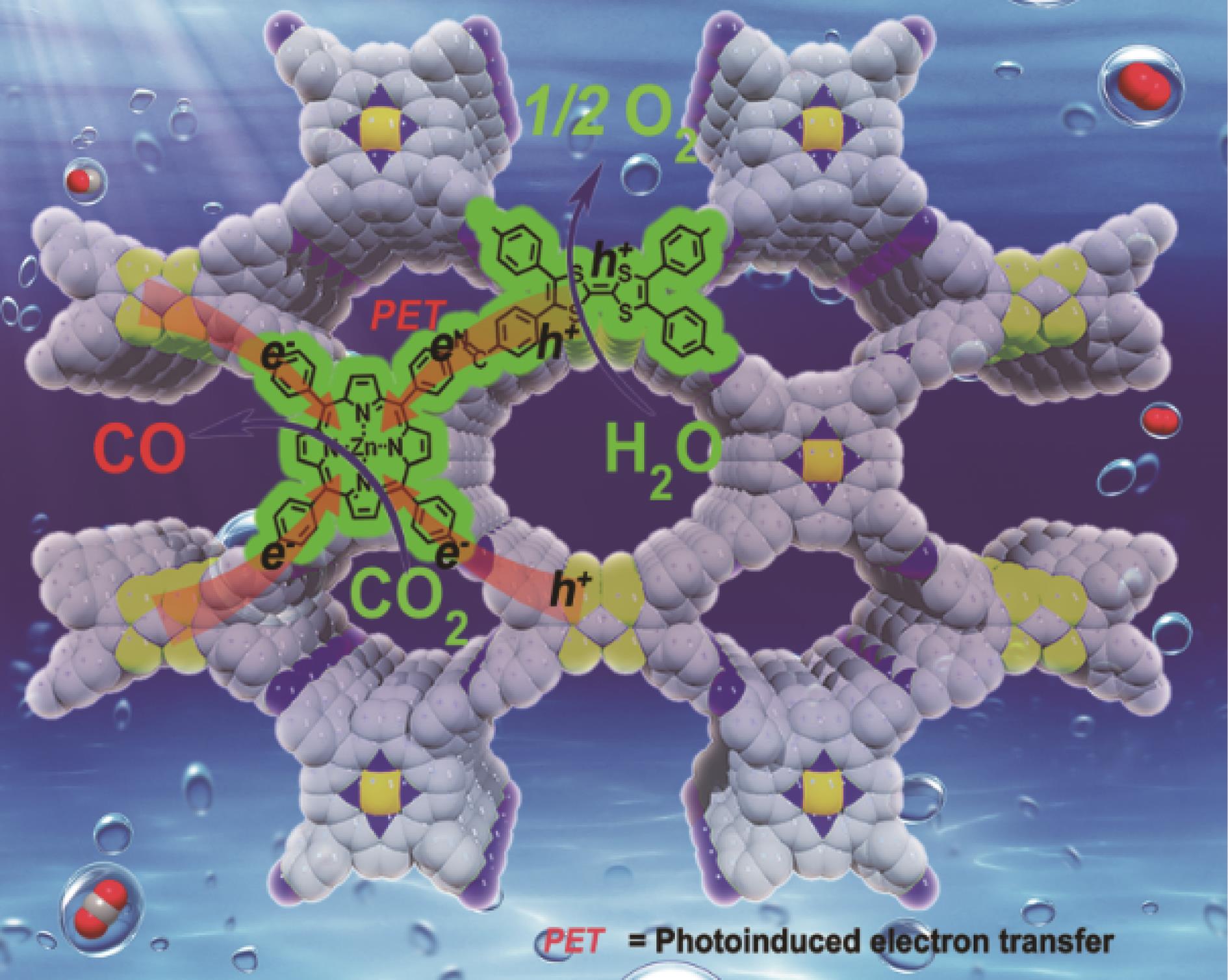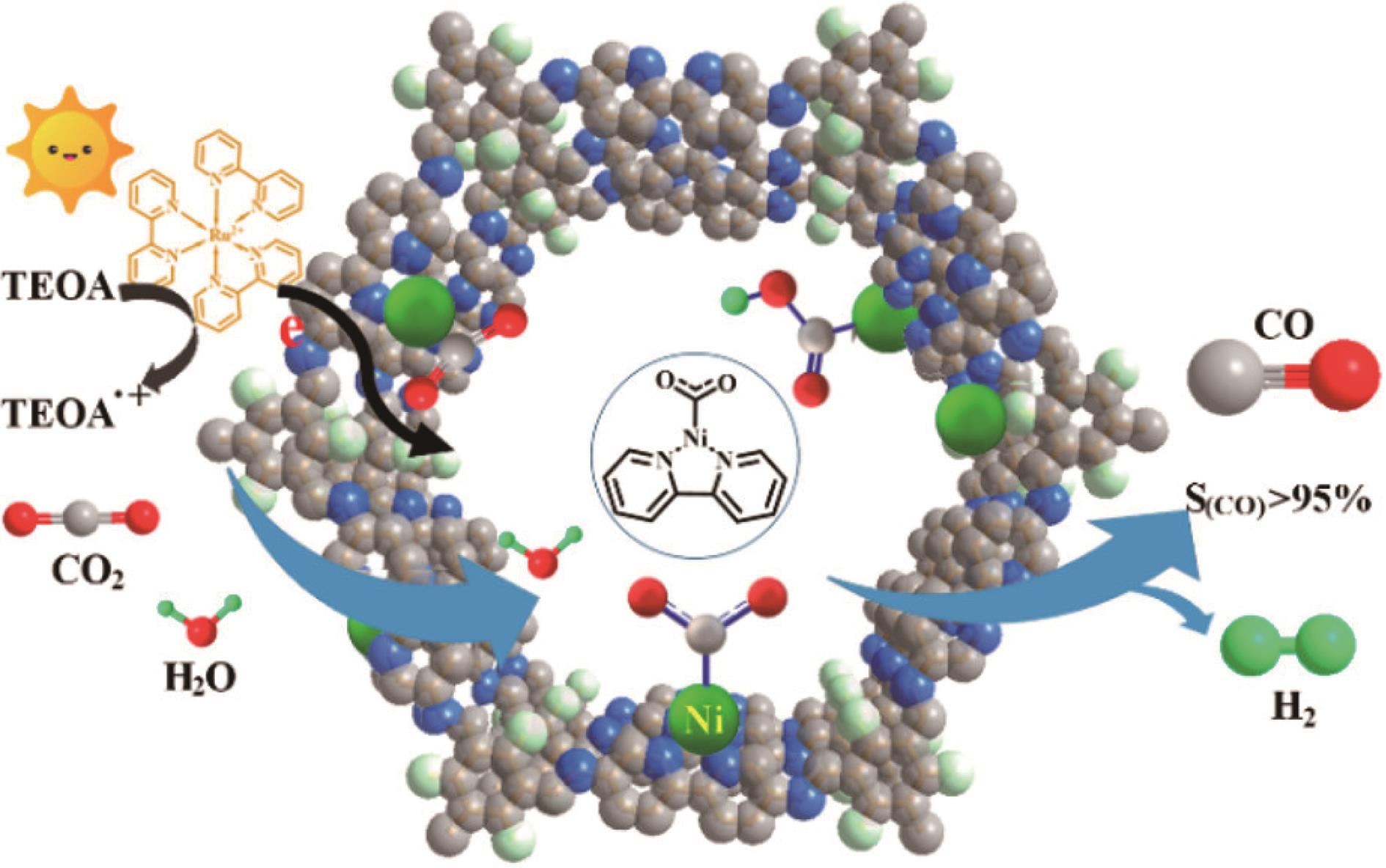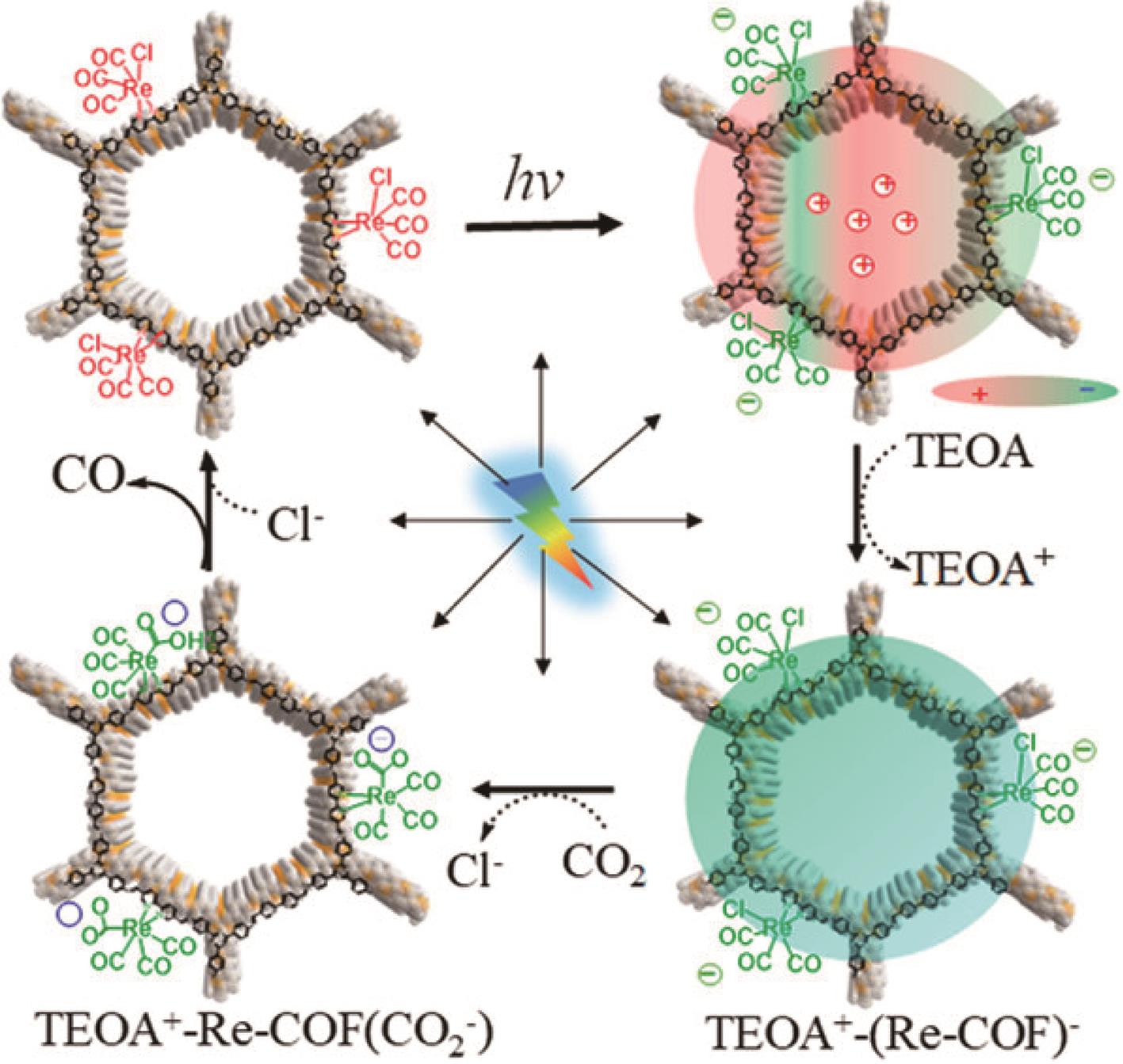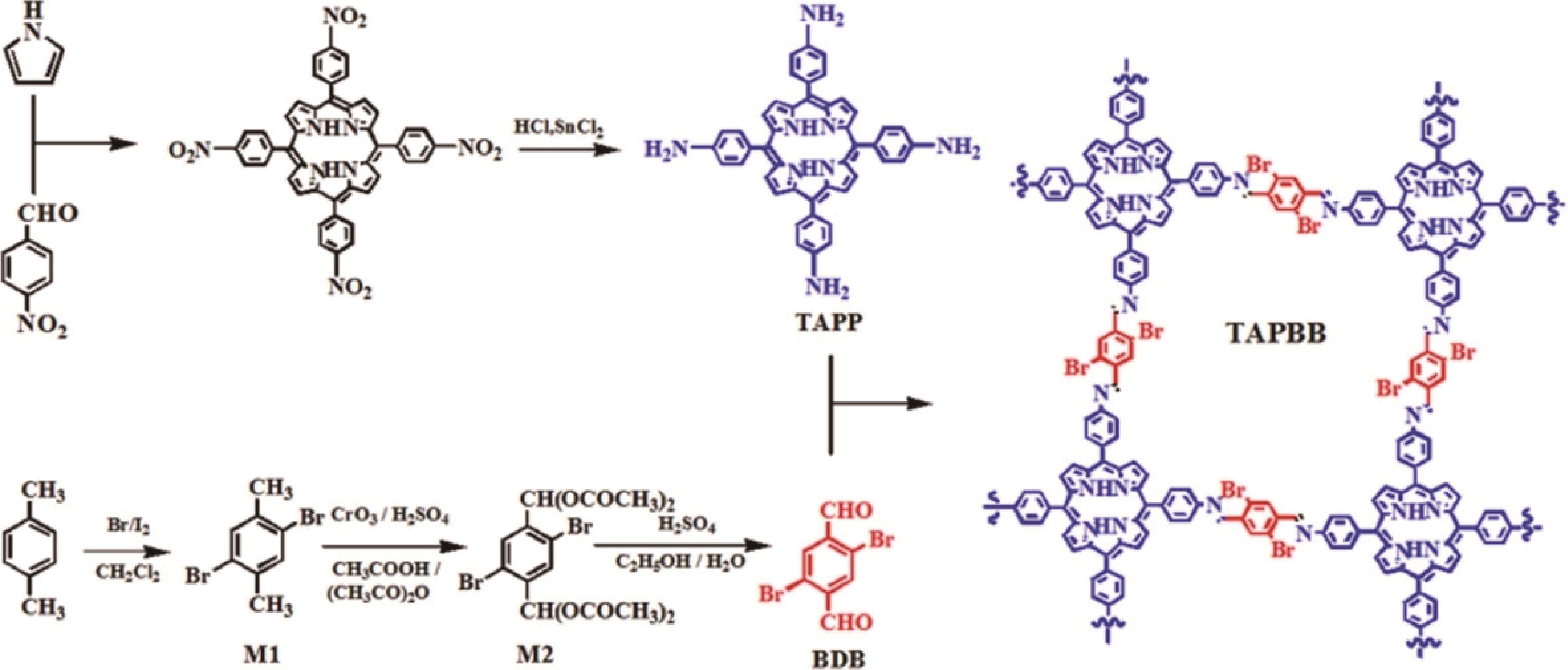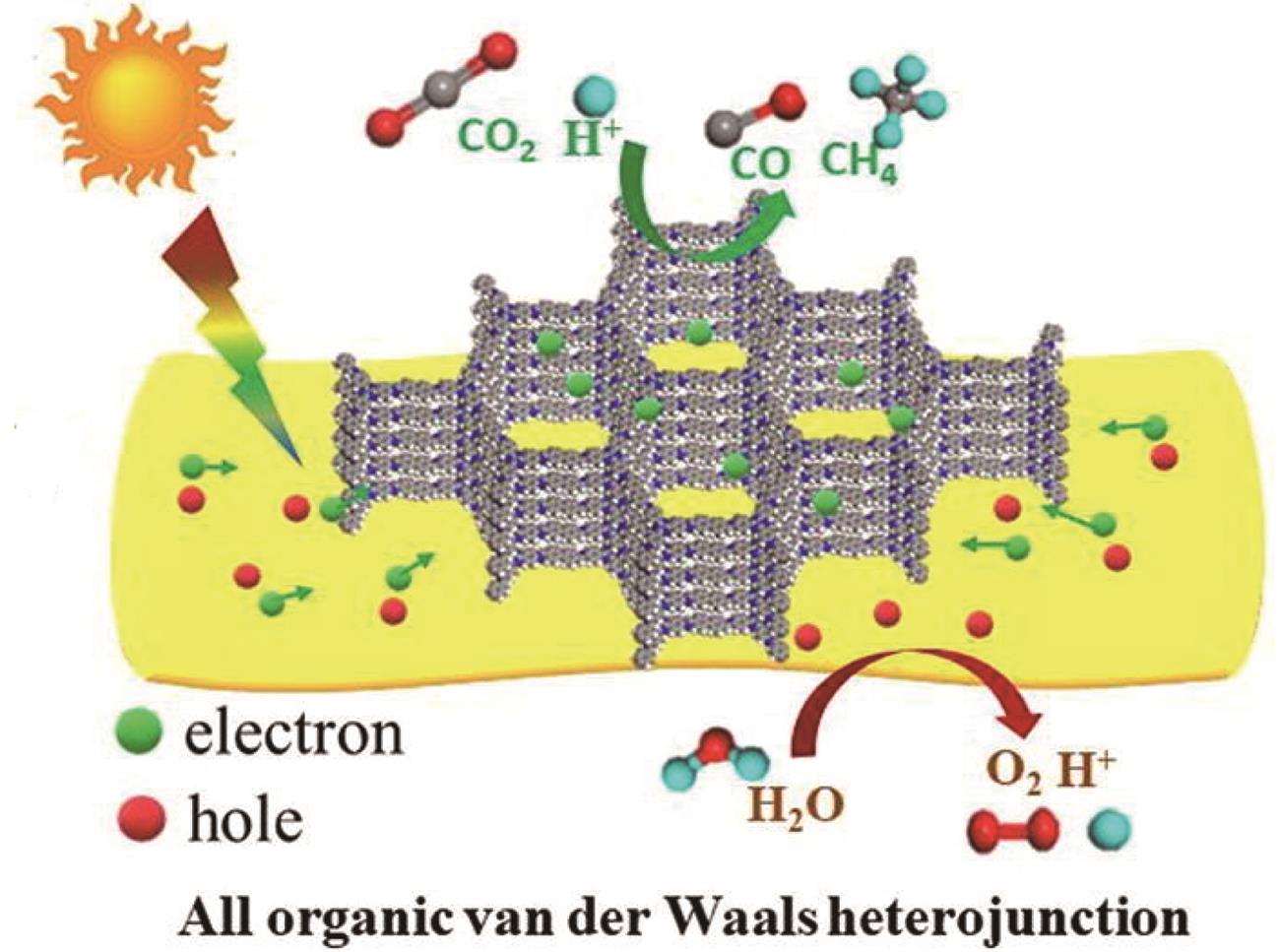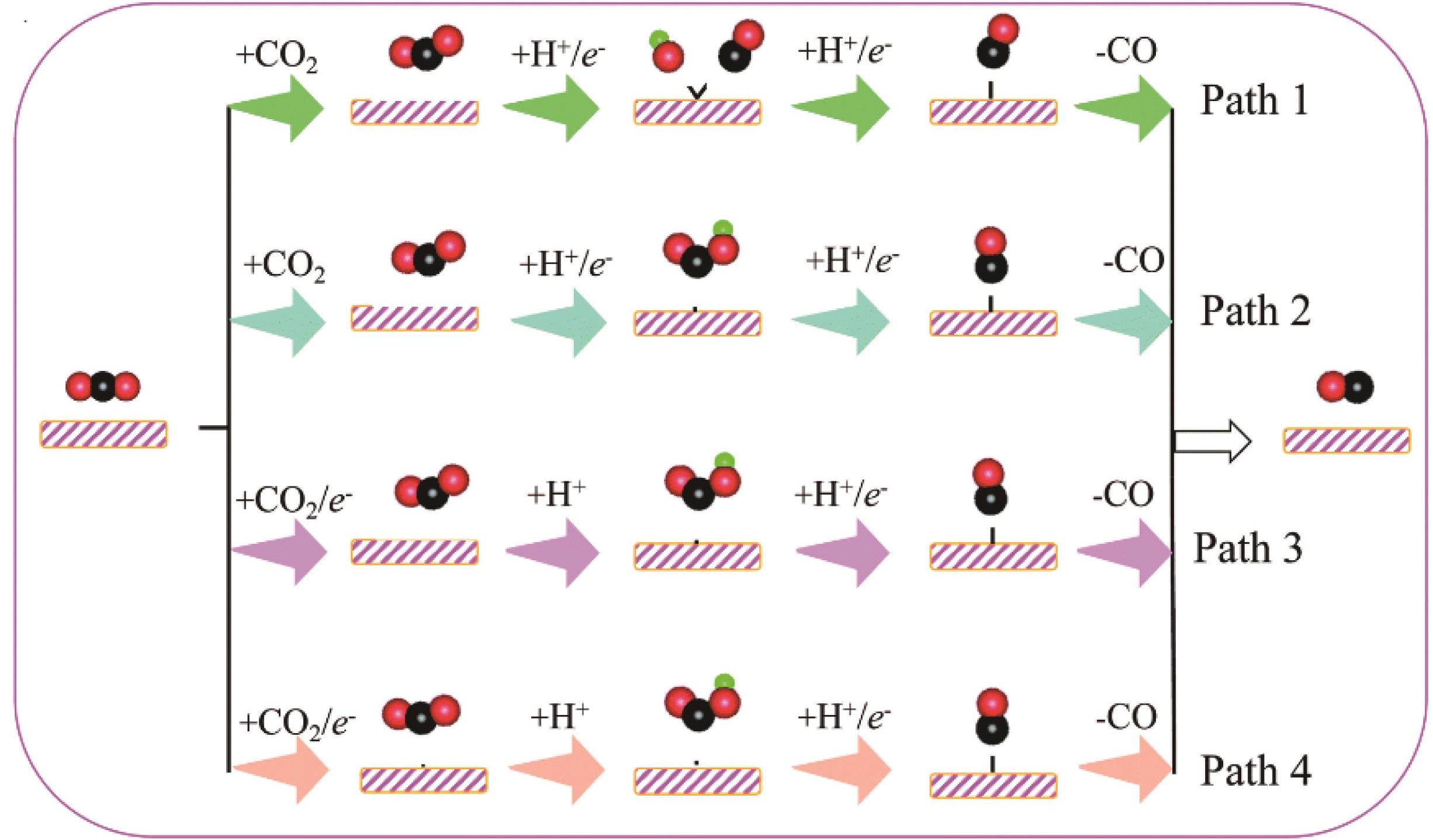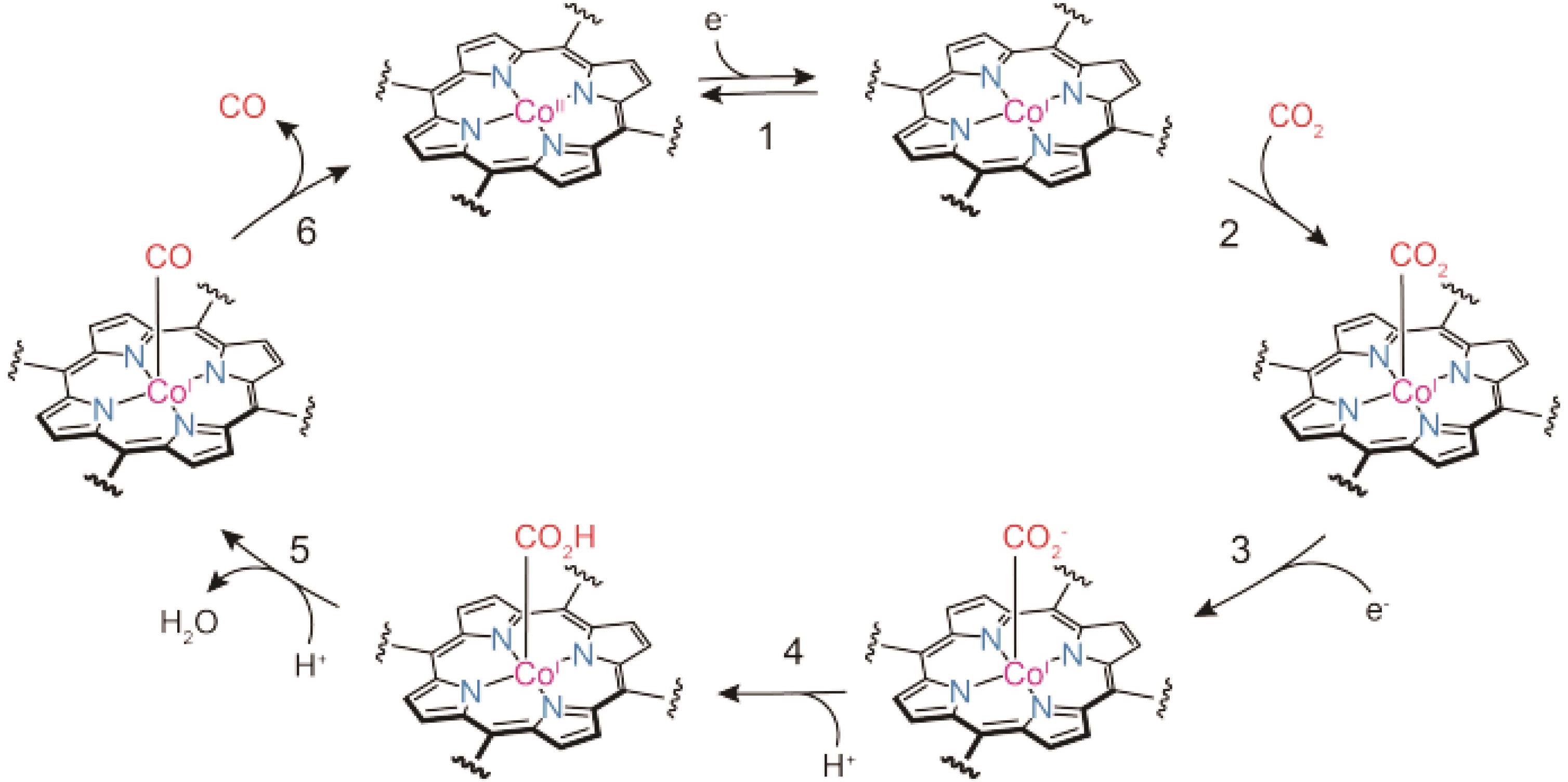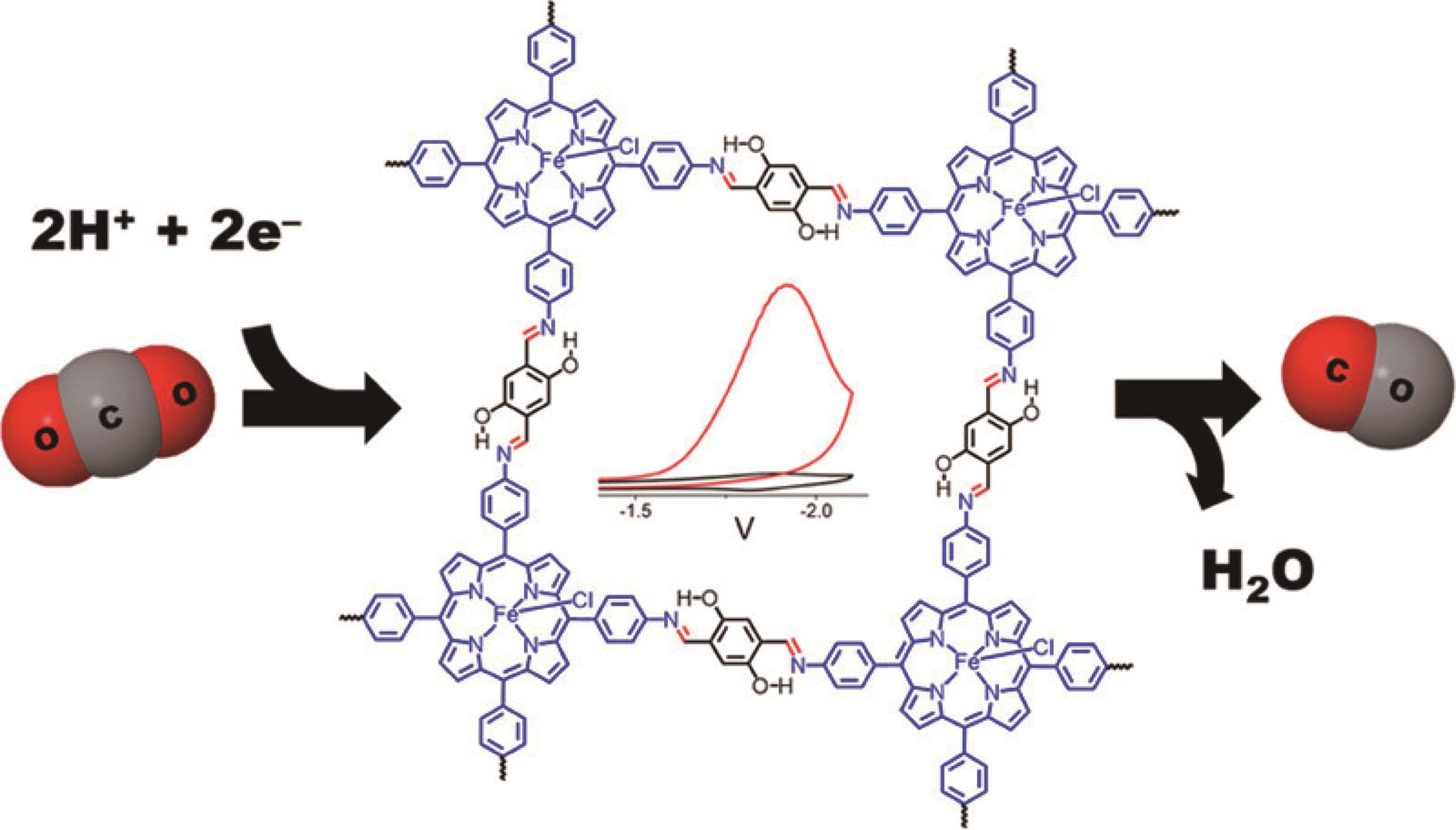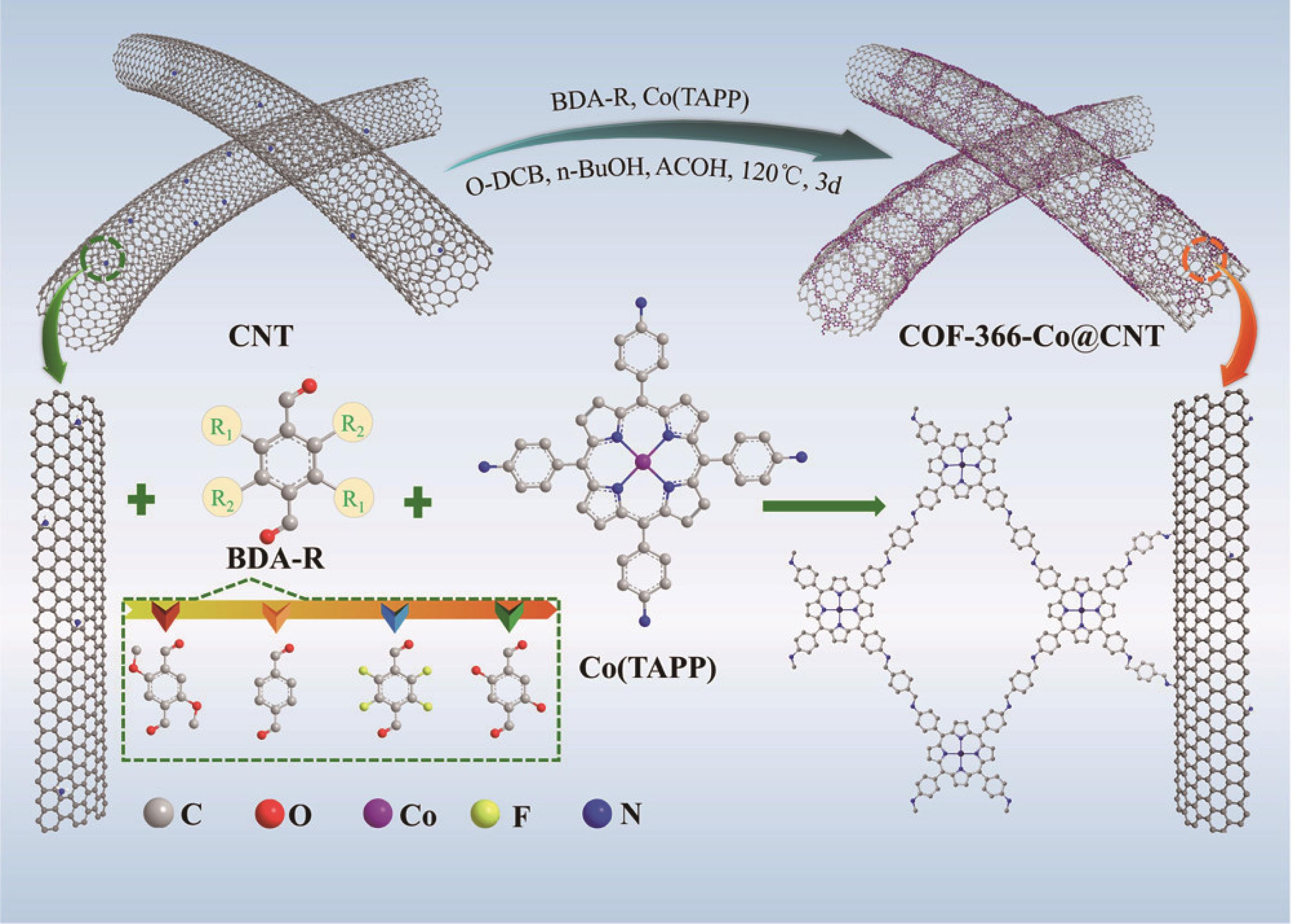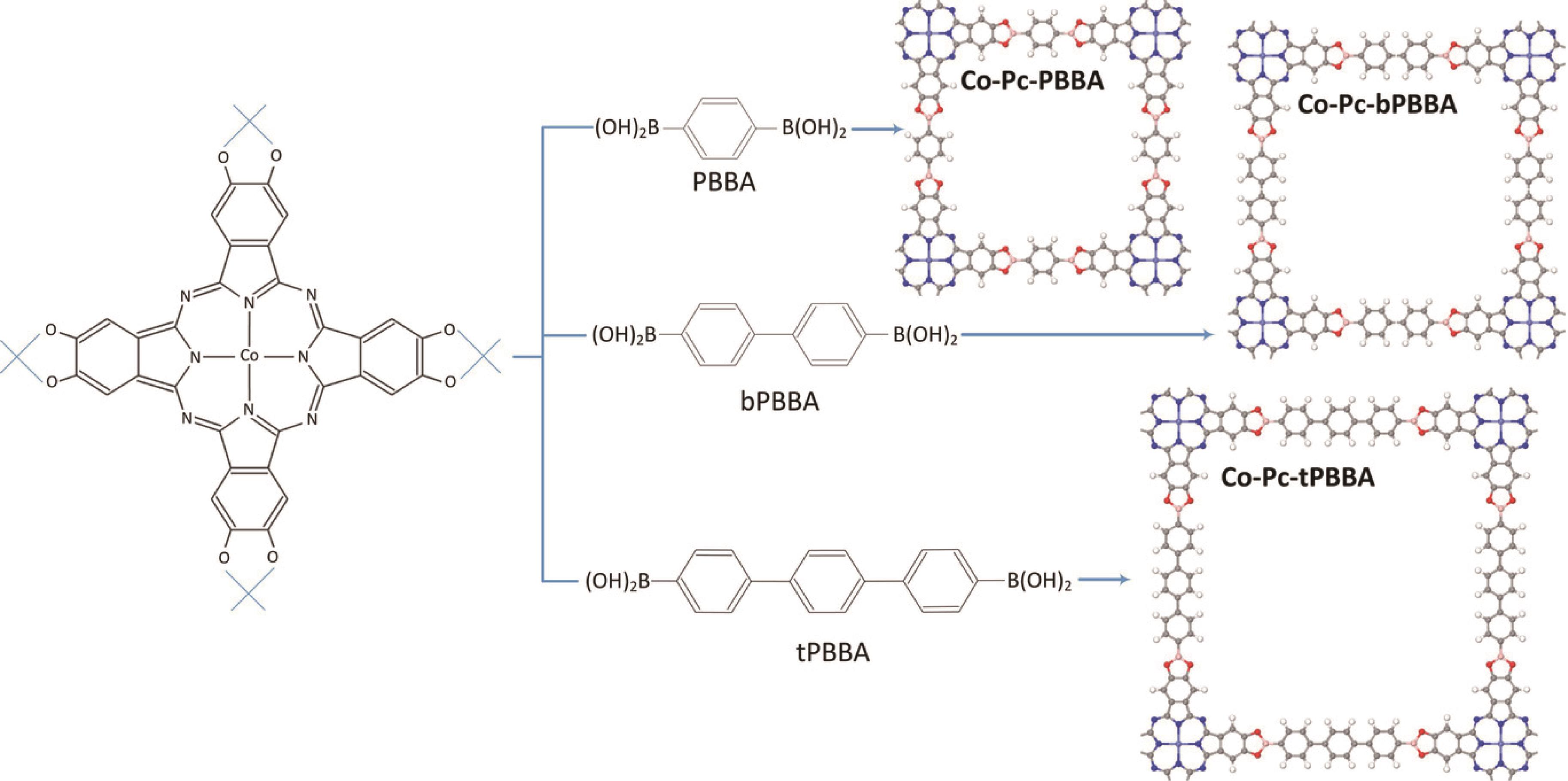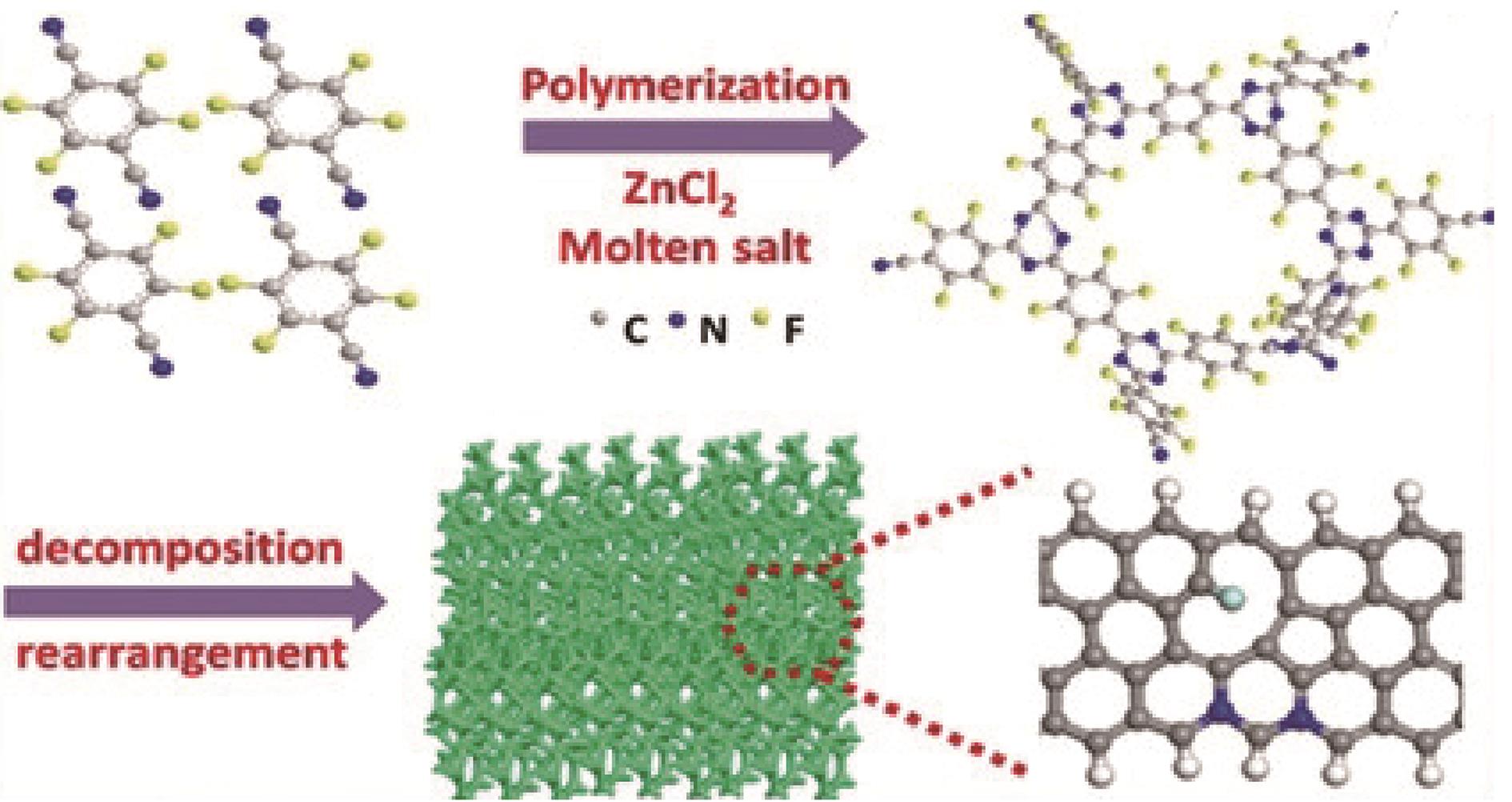
应用化学 ›› 2022, Vol. 39 ›› Issue (4): 559-584.DOI: 10.19894/j.issn.1000-0518.210439
共价有机框架材料用于光/电催化CO2还原的研究进展
- 1.南京师范大学化学与材料科学学院,南京 210023
2.华南师范大学化学学院,广州 510006
-
收稿日期:2021-08-30接受日期:2021-11-24出版日期:2022-04-01发布日期:2022-04-19 -
通讯作者:刘江,兰亚乾 -
作者简介:E-mail: yqlan@njnu.edu.cn
E-mail: liuj@njnu.edu.cn;
-
基金资助:国家自然科学基金(21871141)
Covalent Organic Framework Materials for Photo/ Electrocatalytic Carbon Dioxide Reduction
Lin-Jie SHANG1, Jiang LIU1( ), Ya-Qian LAN2(
), Ya-Qian LAN2( )
)
- 1.School of Chemistry and Materials Science,Nanjing Normal University,Nanjing 210023,China
2.School of Chemistry,South China Normal University,Guangzhou 510006,China
-
Received:2021-08-30Accepted:2021-11-24Published:2022-04-01Online:2022-04-19 -
Contact:Jiang LIU,Ya-Qian LAN -
Supported by:the National Natural Science Foundation of China(21871141)
摘要:
共价有机框架(COFs)是一类通过共价键连接的新兴材料,大部分具有高的热/化学稳定性(除硼酸类COFs)、永久的孔隙率、较大的比表面积和较好的结晶性。此外,COFs中的单体单元结构可调并且可以与许多过渡金属离子配位来提供催化活性位点,这一系列优势使得COFs有利于催化各种反应。其中,COFs对CO2还原反应(CO2RR)有着优异的催化作用。这主要是因为COFs可调控的孔结构使得它可以吸附大量CO2,而且COFs中的π-π堆积结构能促进电荷转移,可以大大提高CO2还原效率。COFs可作为光/电催化剂高效地将CO2还原为CO、CH4和HCOOH等多种产物。本综述讨论了由COFs催化的CO2RR的重要成果,包括光/电催化CO2RR和光电耦合CO2RR。此外,还对COFs作为CO2RR催化剂的未来发展进行了展望。
中图分类号:
引用本文
商林杰, 刘江, 兰亚乾. 共价有机框架材料用于光/电催化CO2还原的研究进展[J]. 应用化学, 2022, 39(4): 559-584.
Lin-Jie SHANG, Jiang LIU, Ya-Qian LAN. Covalent Organic Framework Materials for Photo/ Electrocatalytic Carbon Dioxide Reduction[J]. Chinese Journal of Applied Chemistry, 2022, 39(4): 559-584.
序号 No. | 化学反应 Chemical reactions | 氧化还原电势/V(vs NHE) Oxidation?reduction potential/V(vs NHE) |
|---|---|---|
| (1) | CO2 +2H+ +2e- → CO+H2O | -0.53 |
| (2) | CO2+2H++2e- → HCOOH | -0.61 |
| (3) | CO2+4H++4e- → HCHO+H2O | -0.48 |
| (4) | CO2+4H++4e- → C+2H2O | -0.20 |
| (5) | CO2+6H++6e- → CH3OH+H2O | -0.38 |
| (6) | CO2+8H++8e- → CH4+2H2O | -0.24 |
| (7) | 2CO2 + 12H++12e- → C2H5OH+3H2O | -0.33 |
| (8) | 2CO2+12H++12e- → C2H4+4H2O | -0.34 |
| (9) | 2CO2+14H++14e- → C2H6+4H2O | -0.27 |
| (10) | 3CO2+18H++18e- → C3H7OH+5H2O | -0.32 |
表1 CO2在H2O中还原的主要产物以及相应的还原电势
Table 1 The main products of CO2 reduction in H2O and the corresponding reduction potentials
序号 No. | 化学反应 Chemical reactions | 氧化还原电势/V(vs NHE) Oxidation?reduction potential/V(vs NHE) |
|---|---|---|
| (1) | CO2 +2H+ +2e- → CO+H2O | -0.53 |
| (2) | CO2+2H++2e- → HCOOH | -0.61 |
| (3) | CO2+4H++4e- → HCHO+H2O | -0.48 |
| (4) | CO2+4H++4e- → C+2H2O | -0.20 |
| (5) | CO2+6H++6e- → CH3OH+H2O | -0.38 |
| (6) | CO2+8H++8e- → CH4+2H2O | -0.24 |
| (7) | 2CO2 + 12H++12e- → C2H5OH+3H2O | -0.33 |
| (8) | 2CO2+12H++12e- → C2H4+4H2O | -0.34 |
| (9) | 2CO2+14H++14e- → C2H6+4H2O | -0.27 |
| (10) | 3CO2+18H++18e- → C3H7OH+5H2O | -0.32 |

图1 COF膜光催化剂?酶偶联系统的示意图[40]Rhox=[Cp*Rh(bipy)H2O]2+, Rhred1=Cp*Rh(bipy), Rhred2=[Cp*Rh(bipy)H]+, Cp*=pentamethylcyclopentadienyl, bpy=2,2′-bipyridine
Fig.1 Schematic illustration of the COF film photocatalyst-enzyme coupled system[40]
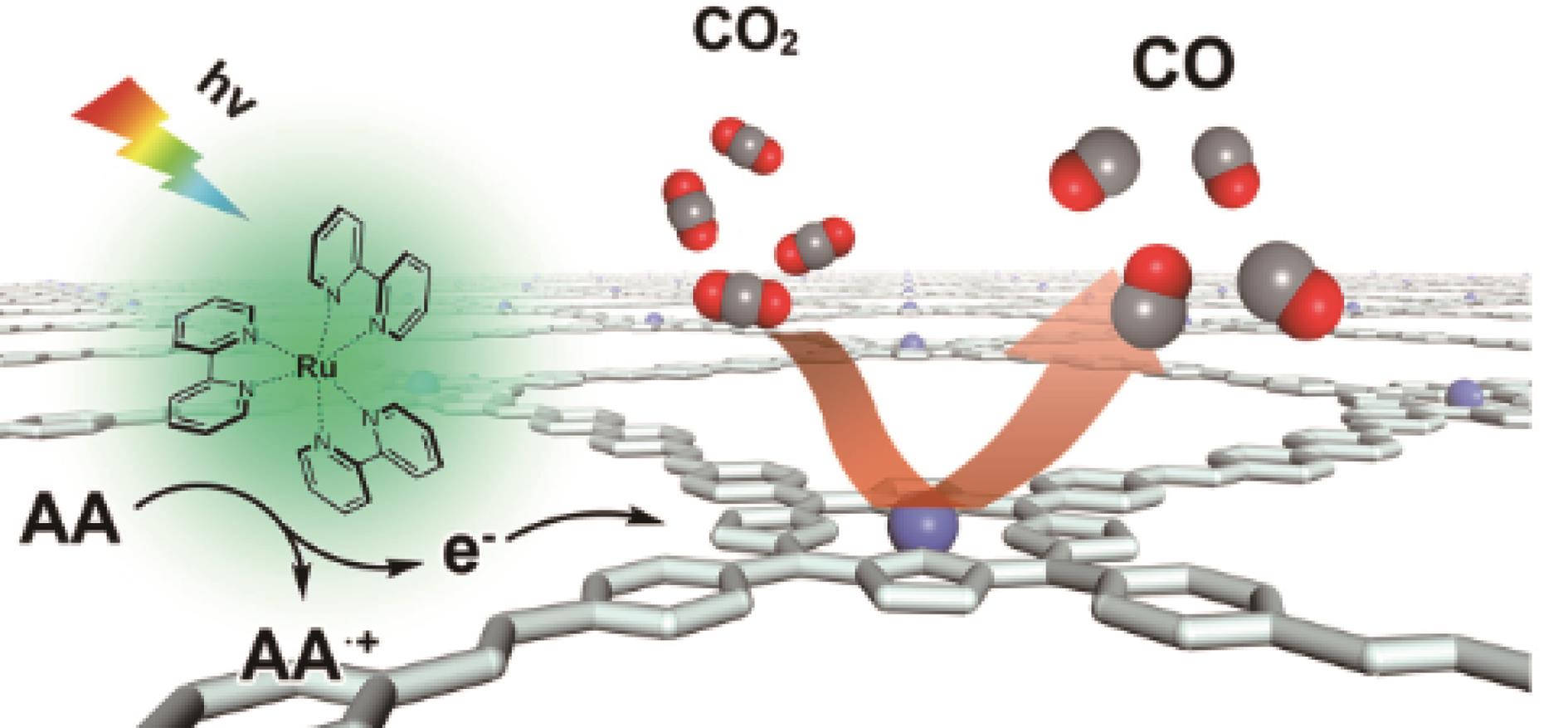
图3 在可见光下,以[Ru(bpy)3]2+为光敏剂,AA为电子给体,在COF-367-Co NSs上将CO2光催化转化为CO[45]
Fig.3 The photocatalytic conversion of CO2 into CO over COF-367-Co NSs under visible-light irradiation with [Ru(bpy)3]2+ as the photosensitizer and AA as the electron donor[45]
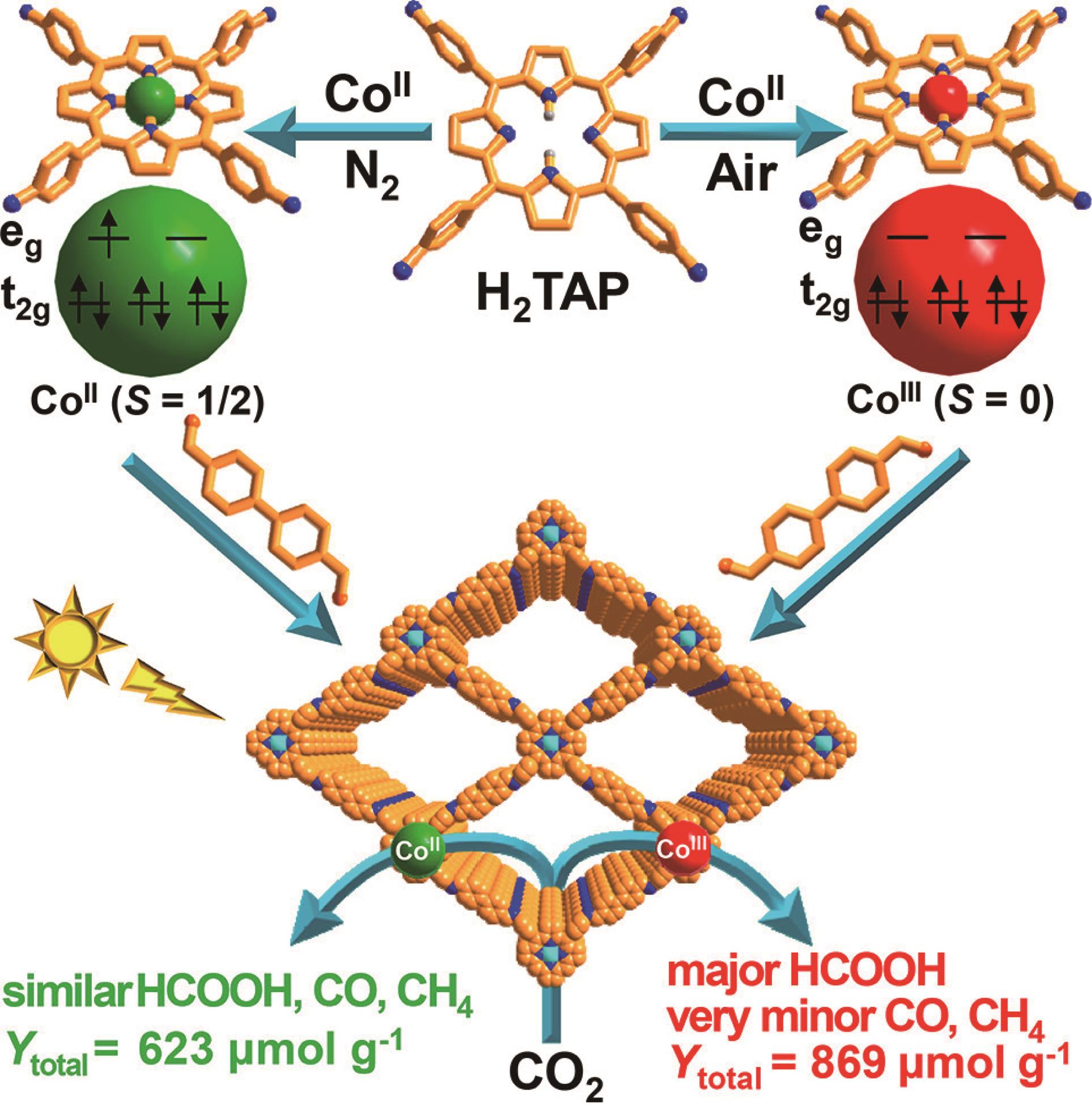
图4 合理构建具有不同Co离子自旋态的COF-367-Co,用于光催化还原CO2[46]
Fig.4 Rational fabrication of COF-367-Co featuring different spin states of Co ions toward photocatalytic CO2 reduction[46]
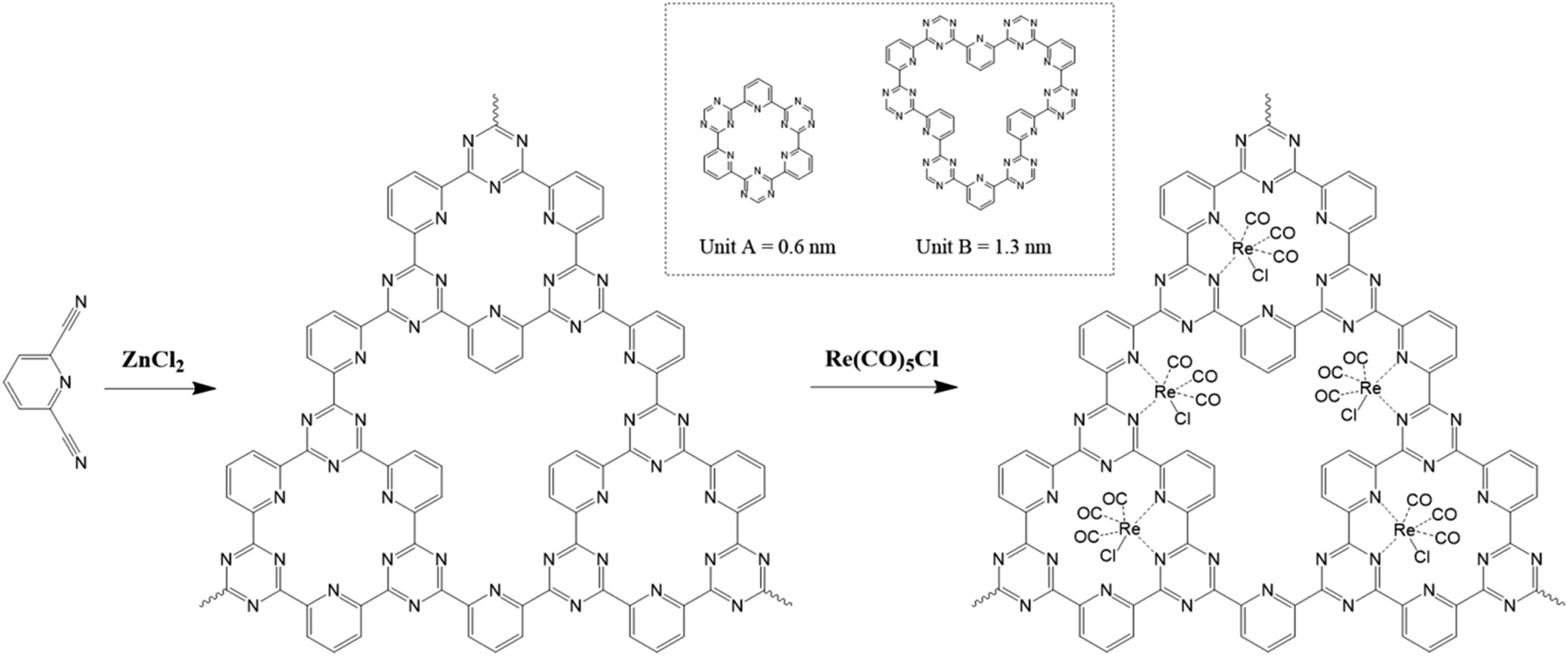
图7 CTF-py和Re-CTF-py材料的合成,插图显示了两种类型的孔(单元A和单元B)[49]
Fig.7 Synthesis of CTF-py and Re-CTF-py materials. The inset shows the two types of pores (unit A and unit B)[49]

图9 在可见光下,通过Co/CTF-1将CO2光催化还原为CO可能机理的示意图[53]
Fig.9 Schematic illustration of the possible photocatalytic reduction of CO2 to CO mechanism over Co/CTF-1 under visible light[53]
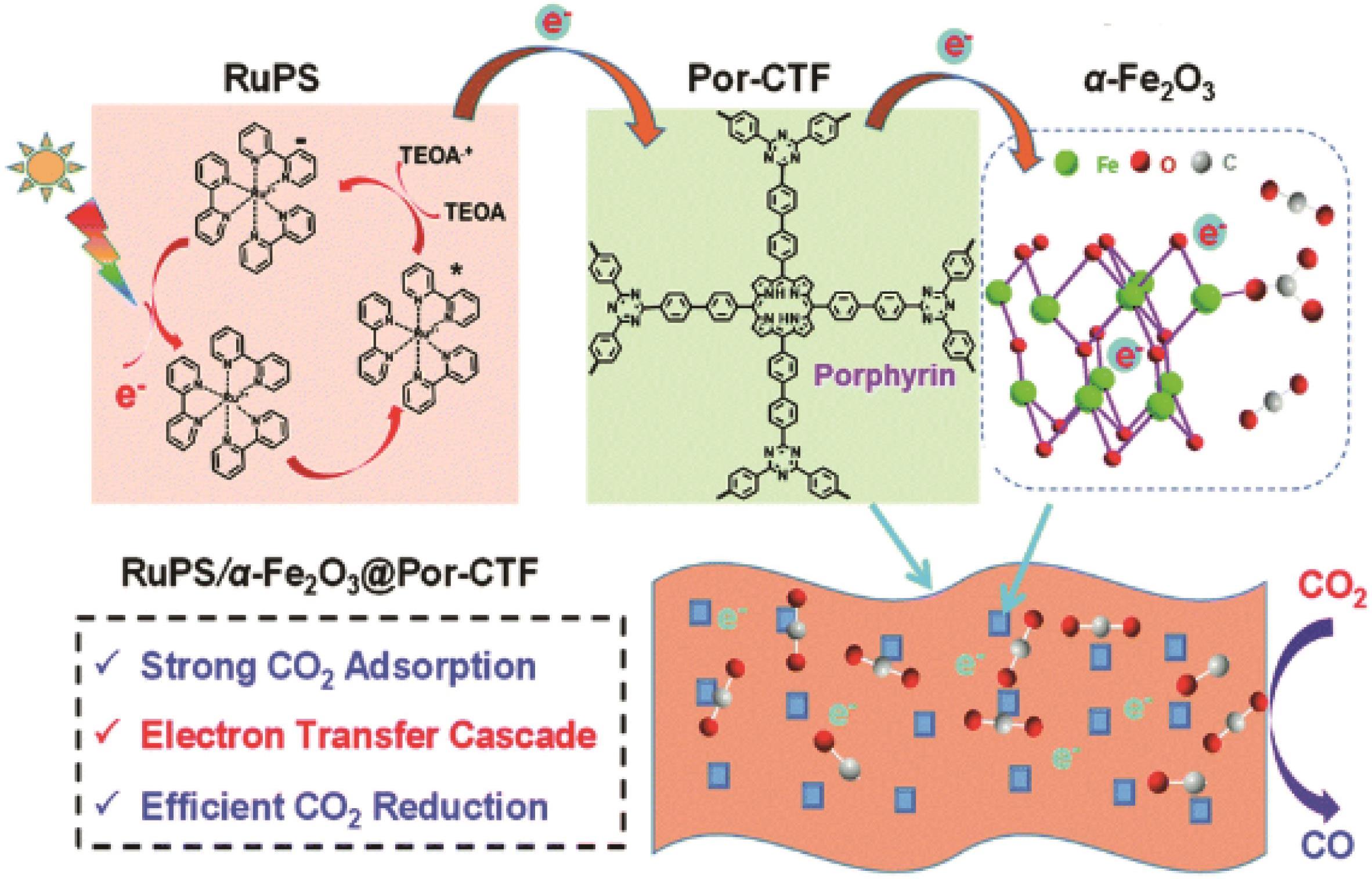
图10 光化学反应机理,包括以Por-CTF作为三元混合体系中CO2还原的中继促进剂的电子转移中继过程[54]
Fig.10 Proposed mechanism for the photochemical reaction comprising an electron transfer relay process with Por-CTF as the relay facilitator for carbon dioxide reduction in a ternary hybrid system[54]
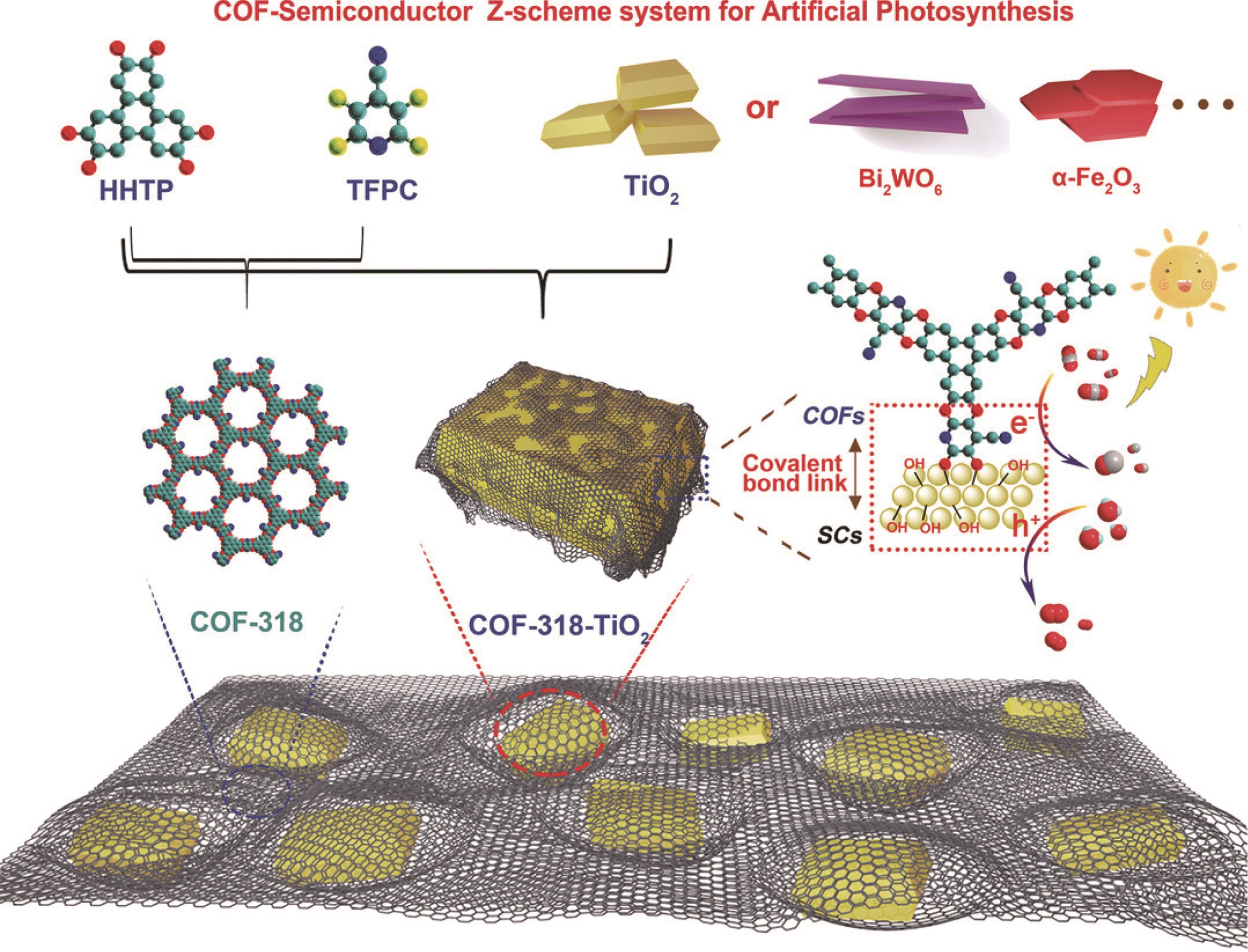
图11 通过COF-318和半导体材料的缩合制备COF-318-SCs的示意图[55]
Fig.11 Schematic representation of the preparation of COF-318-SCs via the condensation of COF-318 and semiconductor materials[55]
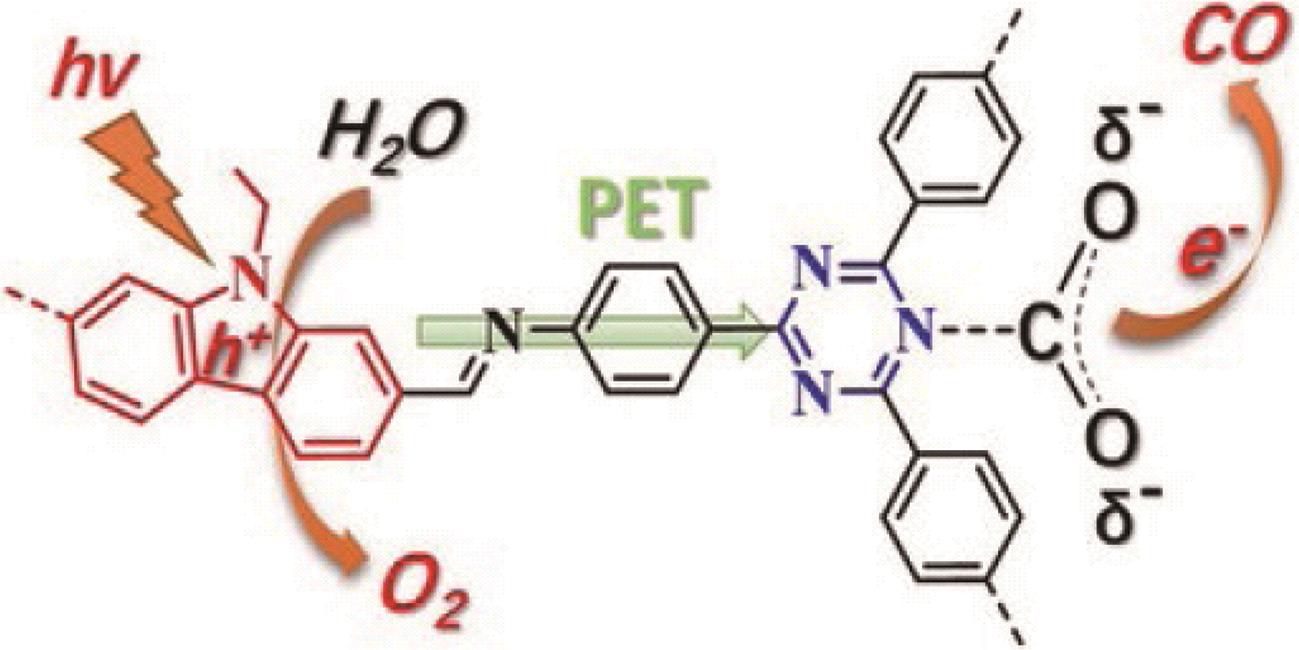
图13 光生电子转移和在CO2光还原中的反应途径(PET =光诱导的电子转移)[57]
Fig.13 Proposed photoactive electron transfer and reaction pathway in the photoreduction of CO2 (PET=photoinduced electron transfer)[57]

图14 COF-TVBT-PA的CO2还原推断路径[58]碳(灰色),氮(蓝色),氧(红色)和氢(白色)
Fig.14 The CO2 reduction inferential path of COF-TVBT-PA[58]Carbon (grey), nitrogen (blue), oxygen (red) and hydrogen (white)

图16 可见光照射下TpBD-X[X=—H2, —(CH3)2, —(OCH3)2, —(NO2)2]光催化还原CO2的示意图[60]
Fig.16 Schematic diagram for the photocatalytic reduction of CO2 over TpBD-X [X=—H2, —(CH3)2, —(OCH3)2 and —(NO2)2] upon visible-light irradiation[60]
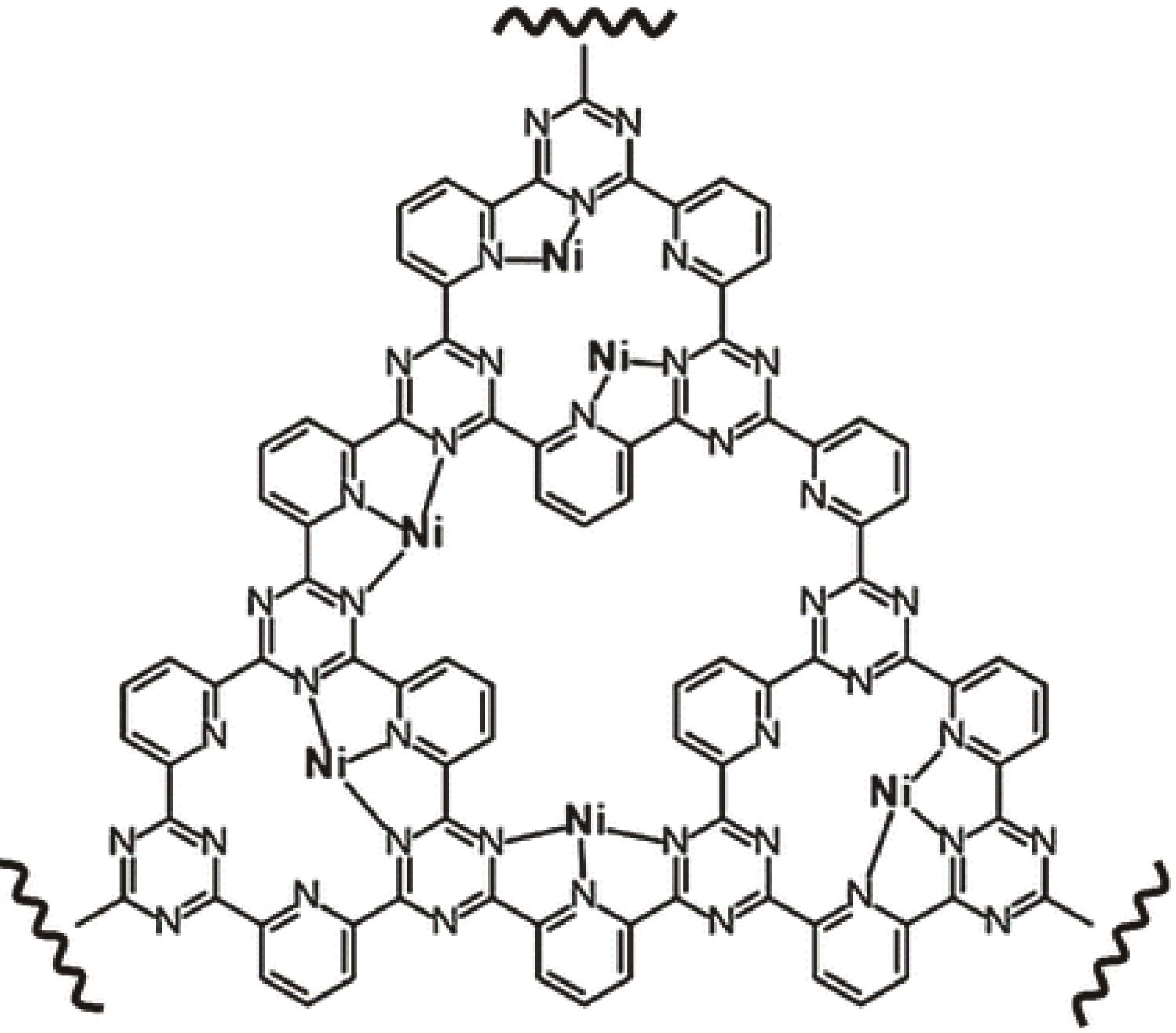
图17 Ni-CTF中Ni的位置图解(为清晰起见,未显示电解质中弱吸附的分子,例如用于制备电极的水和乙醇)[62]
Fig.17 An illustration showing the Ni sites in Ni-CTF (weakly adsorbed molecules in electrolyte, such as water and ethanol used for the preparation of electrode, are not shown for clarity)[62]
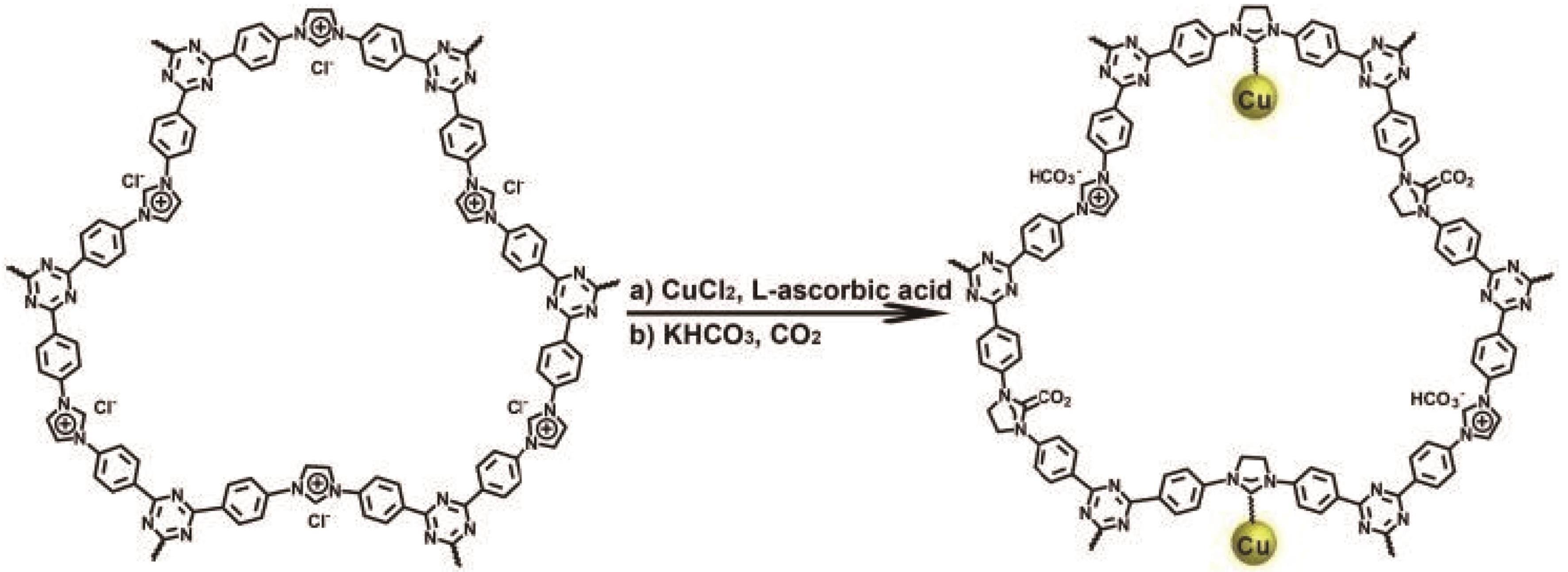
图18 Cu/ICTF的制备及其在CO2RR条件下的转化示意图:含KHCO3(0.1 mol/L)和KCl(0.1 mol/L)溶液的CO2饱和电解液[63]
Fig.18 Schematic representation of the preparation of Cu/ICTF and its transformation in CO2RR conditions: CO2-saturated electrolyte containing a KHCO3 (0.1 mol/L) and KCl (0.1 mol/L) solution[63]
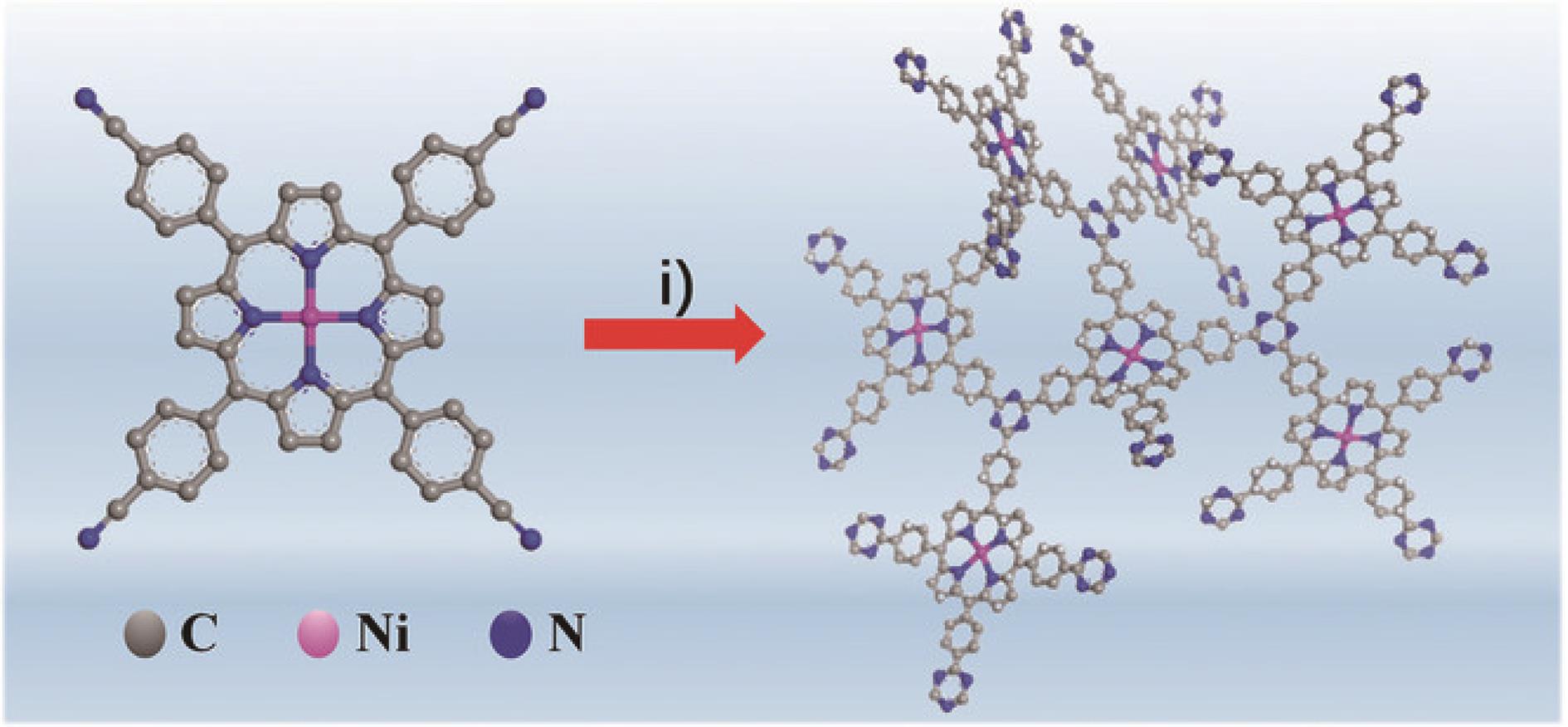
图21 通过电热策略合成NiPor-CTF[67]Balls in grey, blue, and pink represent C, N, and Ni atoms, respectively. All H atoms have been omitted. i) ZnCl2, 400 ℃ for 20 h, and 600 ℃ for 20 h, then HCl (aq.) washing
Fig.21 Synthesis of NiPor-CTF through ionothermal strategy[67]
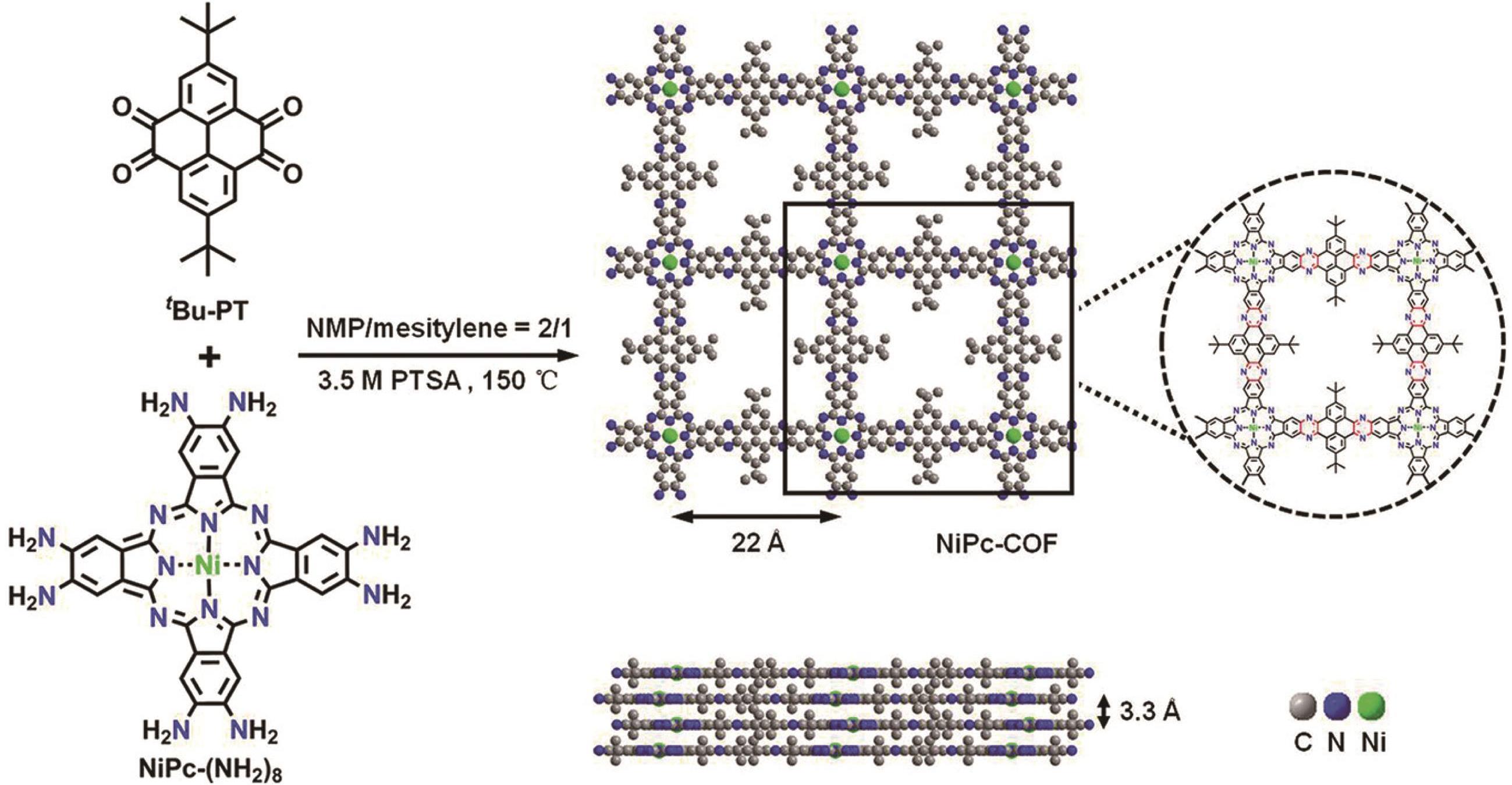
图25 二维导电NiPc-COF的合成示意图,带有AA堆积结构的俯视图和侧视图[73]
Fig.25 Schematic illustration for the synthesis of 2D conductive NiPc-COF with top view and side view of the slipped AA stacking structure[73]
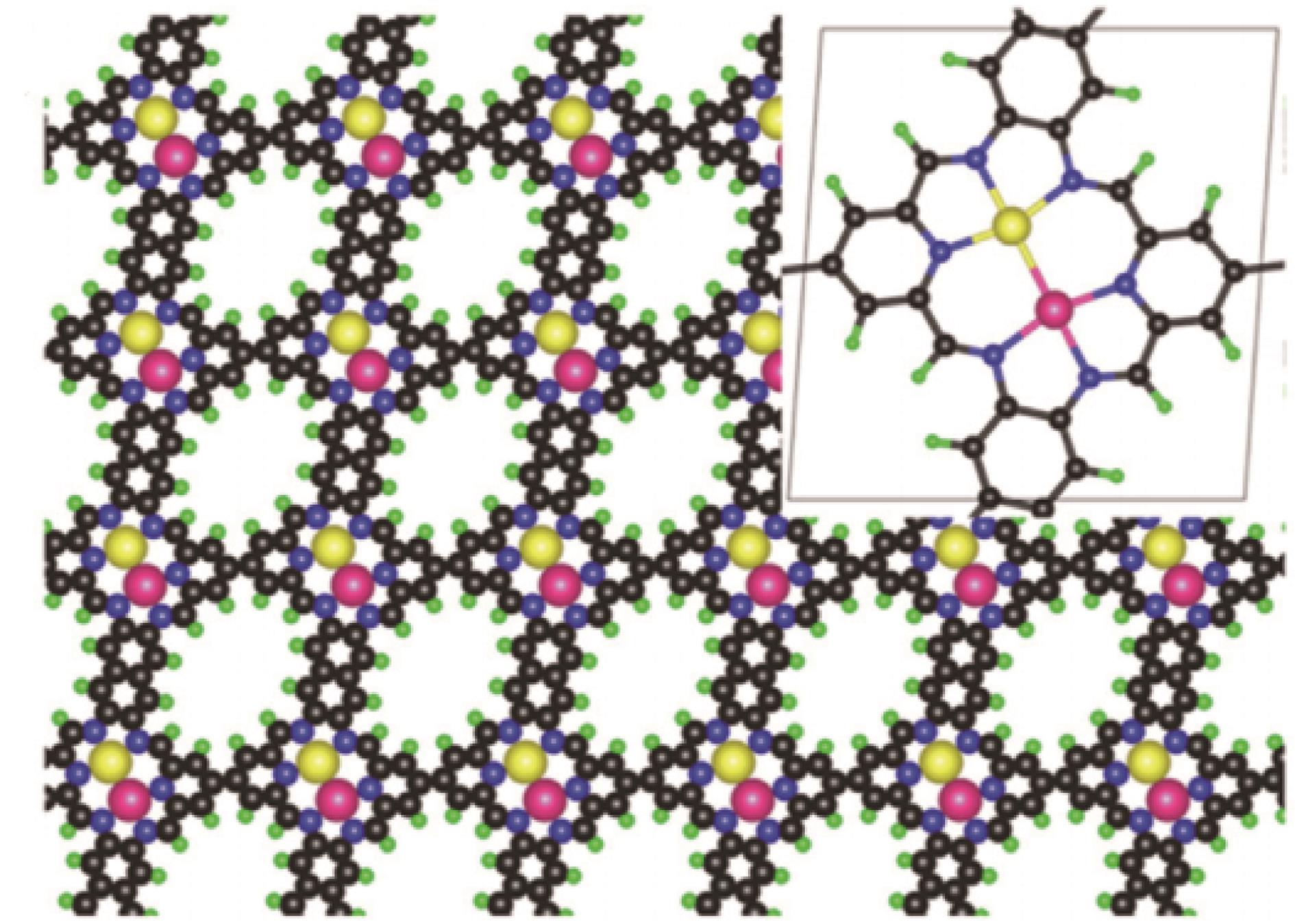
图28 BAC-COFs的结构示意图(右上角的插图是“M1/M2-N6”催化单元)[78]黑色、蓝色、绿色、黄色和粉红色分别代表C、N、H、M1和M2
Fig.28 Schematic diagram of BAC-COFs structure (the inset in the upper right corner is a “M1/M2-N6” catalytic unit)[78]The black, blue, green, yellow and pink colors represent C, N, H, M1 and M2, respectively
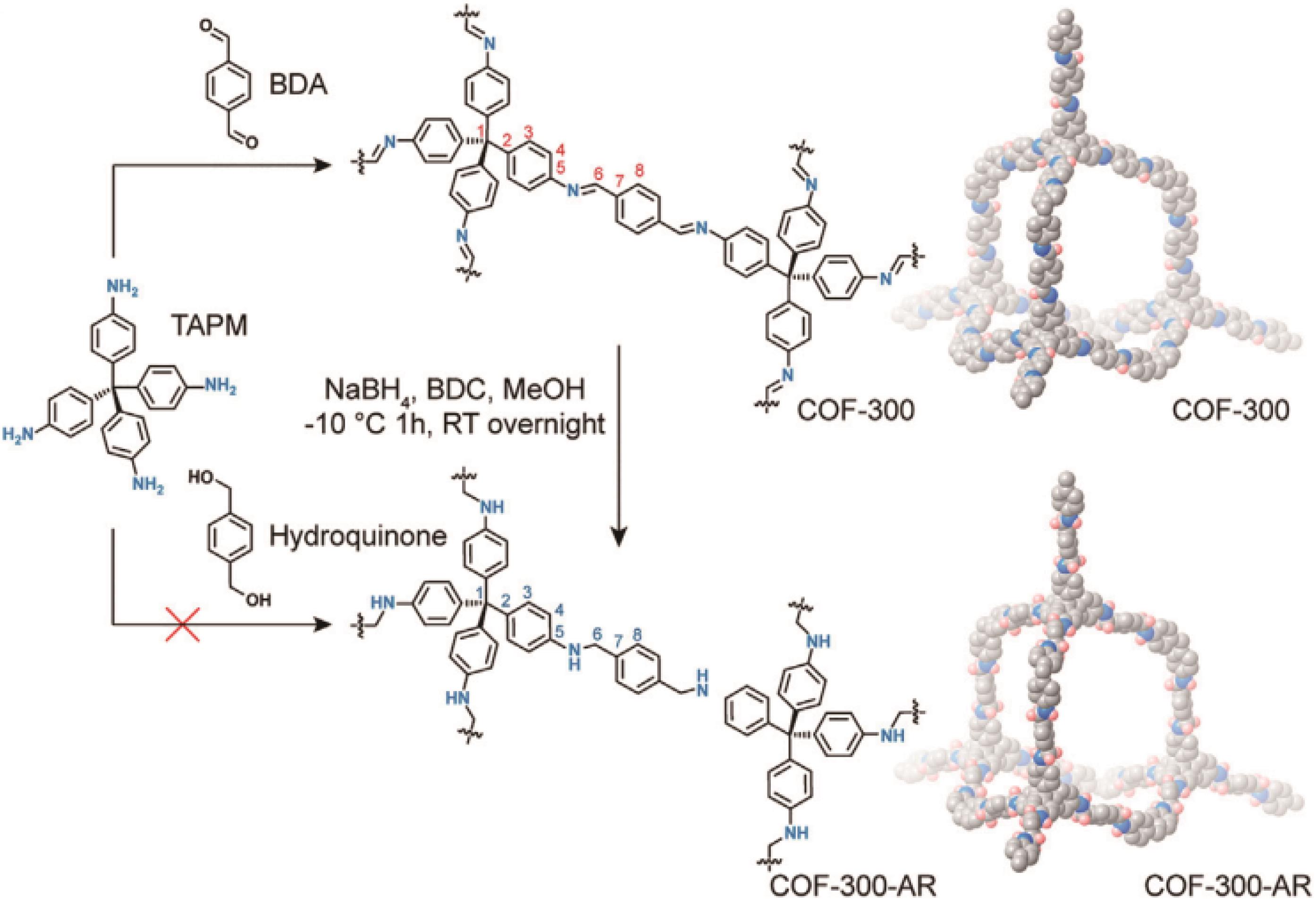
图29 COF-300还原计划[79]BDA, benzene-1,4dicarboxaldehyde; TAPM, terta(4-aminophenyl)methane. In the space-filling diagrams, carbon and nitrogen atoms are represented as gray and blue spheres, respectively. Only the hydrogen atoms on the imine and amine linkage are shown (in pink) for clarity
Fig.29 Scheme for COF-300 reduction[79]
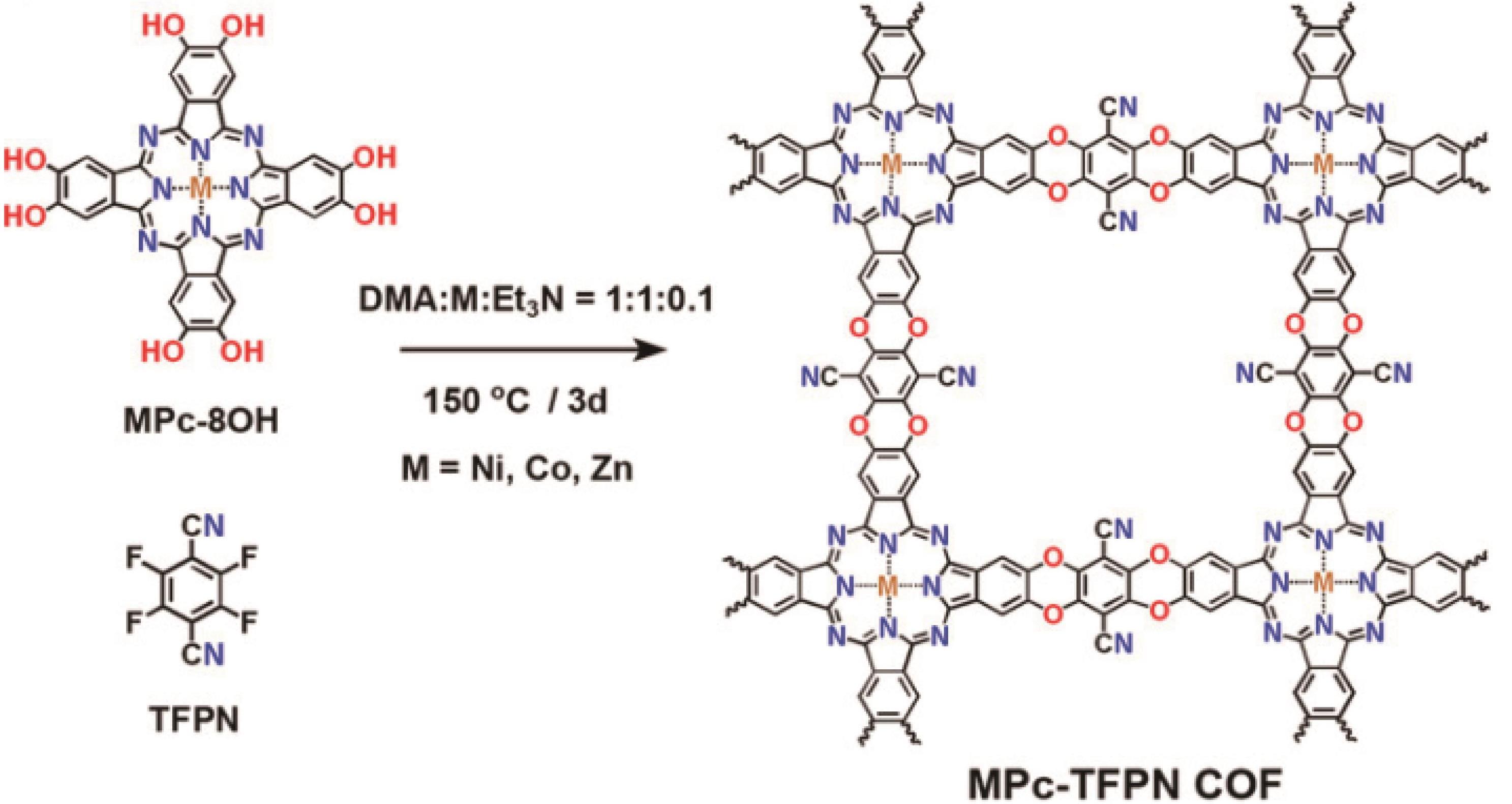
图31 通过MPc-8OH和TFPN缩合合成MPc-TFPN COF的结构示意图[82]
Fig.31 Schematic of the synthesis and structure of MPc-TFPN COF through the condensation of MPc-8OH and TFPN[82]
| 1 | GHADIKOLAEI S S C. An enviroeconomic review of the solar PV cells cooling technology effect on the CO2 emission reduction[J]. Sol Energy, 2021, 216: 468-492. |
| 2 | ANDERSON T R, HAWKINS E, JONES P D. CO2, the greenhouse effect and global warming: from the pioneering work of arrhenius and callendar to today's earth system models[J]. Endeavour, 2016, 40(3): 178-187. |
| 3 | ZHANG L, ZHAO Z J, GONG J L. Nanostructured materials for heterogeneous electrocatalytic CO2 reduction and related reaction mechanisms[J]. Angew Chem Int Ed, 2017, 56(38): 11326-11353. |
| 4 | LI J D, ZHAO D N, LIU J Q, et al. Covalent organic frameworks: a promising materials platform for photocatalytic CO2 reductions[J]. Molecules, 2020, 25(10): 2425. |
| 5 | MORADI M, KHORASHEH F, LARIMI A. Pt nanoparticles decorated Bi-doped TiO2 as an efficient photocatalyst for CO2 photo-reduction into CH4[J]. Sol Energy, 2020, 211: 100-110. |
| 6 | CHENG L J, LIU L Q, WANG D F, et al. Synthesis of bismuth molybdate photocatalysts for CO2 photo-reduction[J]. J CO2 UTIL, 2019, 29: 196-204. |
| 7 | ZHAO S L, QIN Y, GUO T, et al. SnS nanoparticles grown on Sn-atom-modified N,S-codoped mesoporous carbon nanosheets as electrocatalysts for CO2 reduction to formate[J]. ACS Appl Nano Mater, 2021, 4(2): 2257-2264. |
| 8 | CUI X, LEI S, WANG A C, et al. Emerging covalent organic frameworks tailored materials for electrocatalysis[J]. Nano Energy, 2020, 70: 104525. |
| 9 | CHANG X X, WANG T, GONG J L. CO2 photo-reduction: insights into CO2 activation and reaction on surfaces of photocatalysts[J]. Energy Environ Sci, 2016, 9(7): 2177-2196. |
| 10 | VU N N, KALIAGUINE S, DO T O. Critical aspects and recent advances in structural engineering of photocatalysts for sunlight-driven photocatalytic reduction of CO2 into fuels[J]. Adv Funct Mater, 2019, 29(31): 1901825. |
| 11 | JIN H Y, GUO C X, LIU X, et al. Emerging two-dimensional nanomaterials for electrocatalysis[J]. Chem Rev, 2018, 118(13): 6337-6408. |
| 12 | SCHLOGL R. Heterogeneous catalysis[J]. Angew Chem Int Ed, 2015, 54(11): 3465-3520. |
| 13 | ZHU D D, LIU J L, QIAO S Z. Recent advances in inorganic heterogeneous electrocatalysts for reduction of carbon dioxide[J]. Adv Mater, 2016, 28(18): 3423-3452. |
| 14 | SAMANTA S, SRIVASTAVA R. Catalytic conversion of CO2 to chemicals and fuels: the collective thermocatalytic/photocatalytic/electrocatalytic approach with graphitic carbon nitride[J]. Mater Adv, 2020, 1(6): 1506-1545. |
| 15 | WANG G X, CHEN J X, DING Y C, et al. Electrocatalysis for CO2 conversion: from fundamentals to value-added products[J]. Chem Soc Rev, 2021, 50(8): 4993-5061. |
| 16 | DAS S, PÉREZ-RAMÍREZ J, GONG J L, et al. Core-shell structured catalysts for thermocatalytic, photocatalytic, and electrocatalytic conversion of CO2[J]. Chem Soc Rev, 2020, 49(10): 2937-3004. |
| 17 | LI X, LIU H L, LUO D L, et al. Adsorption of CO2 on heterostructure CdS(Bi2S3)/TiO2 nanotube photocatalysts and their photocatalytic activities in the reduction of CO2 to methanol under visible light irradiation[J]. Chem Eng J, 2012, 180: 151-158. |
| 18 | VU N N, KALIAGUINE S, DO T O. Synthesis of g-C3N4/CdS nanocomposite with chemically bonded interface for enhanced sunlight-driven CO2 photoreduction[J]. ACS Appl Energy Mater, 2020, 3(7): 6422-6433. |
| 19 | REÑONES BRASA P, COLLADO L, IGLESIAS-JUEZ A, et al. Silver-gold bimetal loaded TiO2 photocatalysts for CO2 reduction[J]. Ind Eng Chem Res, 2020, 59(20): 9440-9450. |
| 20 | HABISREUTINGER S N, SCHMIDT-MENDE L, STOLARCZYK J K. Photocatalytic reduction of CO2 on TiO2 and other semiconductors[J]. Angew Chem Int Ed, 2013, 52(29): 7372-7408. |
| 21 | LI Y X, WEN M M, WANG Y, et al. Plasmonic hot electrons from oxygen vacancies for infrared light-driven catalytic CO2 reduction on Bi2O3- x[J]. Angew Chem Int Ed, 2021, 60(2): 910-916. |
| 22 | MÖLLER T, SCHOLTEN F, THANH T N, et al. Electrocatalytic CO2 reduction on CuOx nanocubes: tracking the evolution of chemical state, geometric structure, and catalytic selectivity using operando spectroscopy[J]. Angew Chem Int Ed, 2020, 59(41): 17974-17983. |
| 23 | LI H, SUN J W. Highly selective photocatalytic CO2 reduction to CH4 by ball-milled cubic silicon carbide nanoparticles under visible-light irradiation[J]. ACS Appl Mater Interfaces, 2021, 13(4): 5073-5078. |
| 24 | LIU Y, ZHOU W Q, TEO W L, et al. Covalent-organic-framework-based composite materials[J]. Chem, 2020, 6(12): 3172-3202. |
| 25 | BALDWIN L A, CROWE J W, PYLES D A, et al. Metalation of a mesoporous three-dimensional covalent organic framework[J]. J Am Chem Soc, 2016, 138(46): 15134-15137. |
| 26 | ZENG Y F, ZOU R Q, ZHAO Y L. Covalent organic frameworks for CO2 capture[J]. Adv Mater, 2016, 28(15): 2855-2873. |
| 27 | DALAPATI S, JIN S B, GAO J, et al. An azine-linked covalent organic framework[J]. J Am Chem Soc, 2013, 135(46): 17310-17313. |
| 28 | WANG P Y, KANG M M, SUN S M, et al. Imine-linked covalent organic framework on surface for biosensor[J]. Chin J Chem, 2014, 32(9): 838-843. |
| 29 | PENG Y W, HUANG Y, ZHU Y H, et al. Ultrathin two-dimensional covalent organic framework nanosheets: preparation and application in highly sensitive and selective DNA detection[J]. J Am Chem Soc, 2017, 139(25): 8698-8704. |
| 30 | ROTTER J M, WEINBERGER S, KAMPMANN J, et al. Covalent organic framework films through electrophoretic deposition-creating efficient morphologies for catalysis[J]. Chem Mater, 2019, 31(24): 10008-10016. |
| 31 | MA H Z, WEI M, JIN F, et al. A 2D COF with rather low exciton binding energies comparable to 3D inorganic semiconductors in the visible range for water splitting[J]. J Phys Chem C, 2019, 123(40): 24626-24633. |
| 32 | HAO W J, CHEN D, LI Y S, et al. Facile synthesis of porphyrin based covalent organic frameworks via an A2B2 monomer for highly efficient heterogeneous catalysis[J]. Chem Mater, 2019, 31(19): 8100-8105. |
| 33 | AIYAPPA H B, THOTE J, SHINDE D B, et al. Cobalt-modified covalent organic framework as a robust water oxidation electrocatalyst[J]. Chem Mater, 2016, 28(12): 4375-4379. |
| 34 | MU Z J, DING X S, CHEN Z Y, et al. Zwitterionic covalent organic frameworks as catalysts for hierarchical reduction of CO2 with amine and hydrosilane[J]. ACS Appl Mater Interfaces, 2018, 10(48): 41350-41358. |
| 35 | WU X W, HONG Y L, XU B Q, et al. Perfluoroalkyl-functionalized covalent organic frameworks with superhydrophobicity for anhydrous proton conduction[J]. J Am Chem Soc, 2020, 142(33): 14357-14364. |
| 36 | WANG W K, ZHAO W W, XU H T, et al. Fabrication of ultra-thin 2D covalent organic framework nanosheets and their application in functional electronic devices[J]. Coord Chem Rev, 2021, 429: 213616. |
| 37 | REN X H, LIAO G C, LI Z J, et al. Two-dimensional MOF and COF nanosheets for next-generation optoelectronic applications[J]. Coord Chem Rev, 2021, 435: 213781. |
| 38 | SEGURA J L, MANCHEÑO M J, ZAMORA F. Covalent organic frameworks based on Schiff-base chemistry: synthesis, properties and potential applications[J]. Chem Soc Rev, 2016, 45(20): 5635-5671. |
| 39 | WAN S, GÁNDARA F, ASANO A, et al. Covalent organic frameworks with high charge carrier mobility[J]. Chem Mater, 2011, 23(18): 4094-4097. |
| 40 | YADAV R K, KUMAR A, PARK N J, et al. A highly efficient covalent organic framework film photocatalyst for selective solar fuel production from CO2[J]. J Mater Chem A, 2016, 4(24): 9413-9418. |
| 41 | SINGH S, AGGARWAL A, BHUPATHIRAJU N V S D K, et al. Glycosylated porphyrins phthalocyanines, and other porphyrinoids for diagnostics and therapeutics[J]. Chem Rev, 2015, 115(18): 10261-10306. |
| 42 | HAWECKER J, LEHN J M, ZIESSEL R. Efficient photochemical reduction of CO2 to CO by visible light irradiation of systems containing Re(bipy)(CO)3X or Ru(bipy)3 2+-Co2+ combinations as homogeneous catalysts[J]. J Chem Soc, Chem Commun, 1983, 9: 536-538. |
| 43 | KOJIMA T, HONDA T, OHKUBO K, et al. A discrete supramolecular conglomerate composed of two saddle-distorted zinc(Ⅱ)-phthalocyanine complexes and a doubly protonated porphyrin with saddle distortion undergoing efficient photoinduced electron transfer[J]. Angew Chem Int Ed, 2008, 47(35): 6712-6716. |
| 44 | LU M, LIU J, LI Q, et al. Rational design of crystalline covalent organic frameworks for efficient CO2 photoreduction with H2O[J]. Angew Chem Int Ed, 2019, 58(36): 12392-12397. |
| 45 | LIU W B, LI X K, WANG C M, et al. A scalable general synthetic approach towards ultrathin imine-linked two-dimensional covalent organic framework nanosheets for photocatalytic CO2 reduction[J]. J Am Chem Soc, 2019, 141(43): 17431-17440. |
| 46 | GONG Y N, ZHONG W H, LI Y, et al. Regulating photocatalysis by spin-state manipulation of cobalt in covalent organic frameworks[J]. J Am Chem Soc, 2020, 142(39): 16723-16731. |
| 47 | ZHONG W F, SA R J, LI L Y, et al. A covalent organic framework bearing single Ni sites as a synergistic photocatalyst for selective photoreduction of CO2 to CO[J]. J Am Chem Soc, 2019, 141(18): 7615-7621. |
| 48 | YANG S Z, HU W H, ZHANG X, et al. 2D covalent organic frameworks as intrinsic photocatalysts for visible light-driven CO2 reduction[J]. J Am Chem Soc, 2018, 140(44): 14614-14618. |
| 49 | XU R, WANG X S, ZHAO H, et al. Rhenium-modified porous covalent triazine framework for highly efficient photocatalytic carbon dioxide reduction in solid-gas system[J]. Catal Sci Technol, 2018, 8(8): 2224-2230. |
| 50 | PETZOLD D, KÖNIG B. Photocatalytic oxidative bromination of electron-rich arenes and heteroarenes by anthraquinone[J]. Adv Synth Catal, 2018, 360(4): 626-630. |
| 51 | LU M, LI Q, LIU J, et al. Installing earth-abundant metal active centers to covalent organic frameworks for efficient heterogeneous photocatalytic CO2 reduction[J]. Appl Catal B, 2019, 254: 624-633. |
| 52 | DAS P P, CHAUDHARY V, AHMAD F, et al. Effect of nanotoxicity and enhancement in performance of polymer composites using nanofillers: a state-of-the-art review[J]. Polym Composite, 2021, 42(5): 2152-2170. |
| 53 | BI J H, XU B, SUN L, et al. A cobalt-modified covalent triazine-based framework as an efficient cocatalyst for visible-light-driven photocatalytic CO2 reduction[J]. ChemPlusChem, 2019, 84(8): 1149-1154. |
| 54 | ZHANG S Q, WANG S Y, GUO L P, et al. An artificial photosynthesis system comprising a covalent triazine framework as an electron relay facilitator for photochemical carbon dioxide reduction[J]. J Mater Chem C, 2020, 8(1): 192-200. |
| 55 | ZHANG M, LU M, LANG Z L, et al. Semiconductor/covalent-organic-framework Z-scheme heterojunctions for artificial photosynthesis[J]. Angew Chem Int Ed, 2020, 59(16): 6500-6506. |
| 56 | WANG L J, WANG R L, ZHANG X, et al. Improved photoreduction of CO2 with water by tuning the valence band of covalent organic frameworks[J]. ChemSusChem, 2020, 13(11): 2973-2980. |
| 57 | LEI K, WANG D, YE L Q, et al. A metal-free donor-acceptor covalent organic framework photocatalyst for visible-light-driven reduction of CO2 with H2O[J]. ChemSusChem, 2020, 13(7): 1725-1729. |
| 58 | ZHOU J, CUI J X, DONG M, et al. Synergetic effect of H+ adsorption and ethylene functional group of covalent organic frameworks on the CO2 photoreduction in aqueous solution[J]. Chem Commun, 2020, 56(53): 7261-7264. |
| 59 | SONG X H, WU Y F, ZHANG X Y, et al. Boosting charge carriers separation and migration efficiency via fabricating all organic van der Waals heterojunction for efficient photoreduction of CO2[J]. Chem Eng J, 2021, 408: 127292. |
| 60 | PENG L L, CHANG S Q, LIU Z L, et al. Visible-light-driven photocatalytic CO2 reduction over ketoenamine-based covalent organic frameworks: role of the host functional groups[J]. Catal Sci Technol, 2021, 11(5): 1717-1724. |
| 61 | LIN S, DIERCKS C S, ZHANG Y B, et al. Covalent organic frameworks comprising cobalt porphyrins for catalytic CO2 reduction in water[J]. Science, 2015, 349(6253): 1208-1213. |
| 62 | SU P P, IWASE K, HARADA T, et al. Covalent triazine framework modified with coordinatively-unsaturated Co or Ni atoms for CO2 electrochemical reduction[J]. Chem Sci, 2018, 9(16): 3941-3947. |
| 63 | MAO M J, ZHANG M D, MENG D L, et al. Imidazolium-functionalized cationic covalent triazine frameworks stabilized copper nanoparticles for enhanced CO2 electroreduction[J]. ChemCatChem, 2020, 12(13): 3530-3536. |
| 64 | GONG L L, WANG X W, ZHENG T, et al. Catalytic mechanism and design principle of coordinately unsaturated single metal atom-doped covalent triazine frameworks with high activity and selectivity for CO2 electroreduction[J]. J Mater Chem A, 2021, 9(6): 3555-3566. |
| 65 | HUANG Z W, HU K Q, MEI L, et al. Potassium ions induced framework interpenetration for enhancing the stability of uranium-based porphyrin MOF with visible-light-driven photocatalytic activity[J]. Inorg Chem, 2021, 60(2): 651-659. |
| 66 | DIERCKS C S, LIN S, KORNIENKO N, et al. Reticular electronic tuning of porphyrin active sites in covalent organic frameworks for electrocatalytic carbon dioxide reduction[J]. J Am Chem Soc, 2018, 140(3): 1116-1122. |
| 67 | LU C B, YANG J, WEI S C, et al. Atomic Ni anchored covalent triazine framework as high efficient electrocatalyst for carbon dioxide conversion[J]. Adv Funct Mater, 2019, 29(10): 1806884. |
| 68 | CHEUNG P L, LEE S K, KUBIAK C P. Facile solvent-free synthesis of thin iron porphyrin COFs on carbon cloth electrodes for CO2 reduction[J]. Chem Mater, 2019, 31(6): 1908-1919. |
| 69 | LU Y, ZHANG J, WEI W B, et al. Efficient carbon dioxide electroreduction over ultrathin covalent organic framework nanolayers with isolated cobalt porphyrin units[J]. ACS Appl Mater Interfaces, 2020, 12(34): 37986-37992. |
| 70 | JIANG Z, WANG Y, ZHANG X, et al. Revealing the hidden performance of metal phthalocyanines for CO2 reduction electrocatalysis by hybridization with carbon nanotubes[J]. Nano Res, 2019, 12: 2330-2334. |
| 71 | WANG M, TORBENSEN K, SALVATORE D, et al. CO2 electrochemical catalytic reduction with a highly active cobalt phthalocyanine[J]. Nat Commun, 2019, 10: 3602. |
| 72 | YAO C L, LI J C, GAO W, et al. An integrated design with new metal-functionalized covalent organic frameworks for effective electroreduction of CO2[J]. Chem-Eur J, 2018, 24(43): 11051-11058. |
| 73 | ZHANG M D, SI D H, YI J D, et al. Conductive phthalocyanine-based covalent organic framework for highly efficient electroreduction of carbon dioxide[J]. Small, 2020, 16(52): 2005254. |
| 74 | KEITH J A, GRICE K A, KUBIAK C P, et al. Elucidation of the selectivity of proton-dependent electrocatalytic CO2 reduction by fac-Re(bpy)(CO)3Cl[J]. J Am Chem Soc, 2013, 135(42): 15823-15829. |
| 75 | POPOV D A, LUNA J M, ORCHANIAN N M, et al. A 2,2'-bipyridine-containing covalent organic framework bearing rhenium(I) tricarbonyl moieties for CO2 reduction[J]. Dalton Trans, 2018, 47(48): 17450-17460. |
| 76 | JIAO J Q, LIN R, LIU S J, et al. Copper atom-pair catalyst anchored on alloy nanowires for selective and efficient electrochemical reduction of CO2[J]. Nat Chem, 2019, 11(3): 222-228. |
| 77 | JOHNSON E M, HAIGES R, MARINESCU S C. Covalent-organic frameworks composed of rhenium bipyridine and metal porphyrins: designing heterobimetallic frameworks with two distinct metal sites[J]. ACS Appl Mater Interfaces, 2018, 10(44): 37919-37927. |
| 78 | GONG L L, ZHANG D T, SHEN Y, et al. Enhancing both selectivity and activity of CO2 conversion by breaking scaling relations with bimetallic active sites anchored in covalent organic frameworks[J]. J Catal, 2020, 390: 126-134. |
| 79 | LIU H Y, CHU J, YIN Z L, et al. Covalent organic frameworks linked by amine bonding for concerted electrochemical reduction of CO2[J]. Chem, 2018, 4(7): 1696-1709. |
| 80 | WANG Y S, CHEN J X, WANG G X, et al. Perfluorinated covalent triazine framework derived hybrids for the highly selective electroconversion of carbon dioxide into methane[J]. Angew Chem Int Ed, 2018, 57(40): 13120-13124. |
| 81 | HUANG X F, SHEN Q, LIU J B, et al. A CO2 adsorption-enhanced semiconductor/metal-complex hybrid photoelectrocatalytic interface for efficient formate production[J]. Energy Environ Sci, 2016, 9(10): 3161-3171. |
| 82 | LU M, ZHANG M, LIU C G, et al. Stable dioxin-linked metallophthalocyanine covalent organic frameworks as photo-coupled electrocatalysts for CO2 reduction[J]. Angew Chem Int Ed, 2021, 60(9): 4864-4871. |
| [1] | 雷学博, 刘慧景, 丁赫宇, 申国栋, 孙润军. 用于降解印染废水中有机污染物的光催化剂的研究进展[J]. 应用化学, 2023, 40(5): 681-696. |
| [2] | 王路飞, 甄蒙蒙, 沈伯雄. 贫电解液下电催化剂对调控锂硫电池性能的研究进展[J]. 应用化学, 2023, 40(2): 188-209. |
| [3] | 杜卫民, 刘欣, 朱琳, 付佳敏, 郭文山, 杨晓晴, 双培硕. 三元镍基硫属化物纳米棒阵列的简单合成及其高效的电催化析氧性能[J]. 应用化学, 2022, 39(8): 1252-1261. |
| [4] | 刘盛杰, 叶永杰, 刘银怡, 林淑满, 谢浩源, 刘文婷, 许伟钦. 基于泡沫铜的多孔碳均匀负载Cu3P纳米颗粒的制备及其光催化降解染料性能[J]. 应用化学, 2022, 39(7): 1090-1097. |
| [5] | 张晓丽, 彭玉美, 王庆伟, 秦利霞, 刘肖霞, 康诗钊, 李向清. 纳米Ag/TiO2纳米管阵列基底构建及表面增强拉曼散射光谱检测与降解盐酸四环素[J]. 应用化学, 2022, 39(7): 1147-1156. |
| [6] | 张超. 单原子催化剂电催化还原二氧化碳研究进展[J]. 应用化学, 2022, 39(6): 871-887. |
| [7] | 王岩, 张树聪, 汪兴坤, 刘志承, 王焕磊, 黄明华. 电解海水析氢反应过渡金属基催化剂的研究进展[J]. 应用化学, 2022, 39(6): 927-940. |
| [8] | 徐一鑫, 王爽, 全静, 高婉婷, 宋天群, 杨梅. 二硫化钼量子点/还原氧化石墨烯复合材料的制备及其光催化降解有机染料、四环素和Cr(VI)[J]. 应用化学, 2022, 39(5): 769-778. |
| [9] | 曹维锦, 白璐, 武兰兰, 李敬德, 宋术岩. 多壳层中空镍钴双金属磷化物纳米球用于高效电催化析氧[J]. 应用化学, 2022, 39(4): 666-672. |
| [10] | 王佳赫, 刘大勇, 刘伟, 王林, 董彪. 纳米TiO2光催化抗菌应用的研究进展[J]. 应用化学, 2022, 39(4): 629-646. |
| [11] | 张艺潆, 李翠艳, 赵杰, 余笑明, 方千荣. 卟啉-硫醚基共价有机框架材料用于氧还原反应电催化剂[J]. 应用化学, 2022, 39(4): 647-656. |
| [12] | 孙立智, 吕浩, 闵晓文, 刘犇. 介孔钯-硼合金纳米颗粒的制备和甲醇氧化电催化性能[J]. 应用化学, 2022, 39(4): 673-684. |
| [13] | 吴小峰, 陈德顺, 马伟, 黄科科. 电喷雾沉积WO3/Fe2TiO5复合光阳极及其光电催化水裂解性能[J]. 应用化学, 2022, 39(4): 694-696. |
| [14] | 逯慧, 李江, 王丽华, 诸颖, 陈静. 原子级精确的币金属纳米团簇在光催化应用方面的研究进展[J]. 应用化学, 2022, 39(11): 1652-1664. |
| [15] | 叶祥志, 邓云水, 刘源, 周咏柳, 贺建雄, 熊春荣. 玻璃球负载非晶态有机钛聚合物提高光催化还原CO2的转换频率[J]. 应用化学, 2022, 39(10): 1554-1563. |
| 阅读次数 | ||||||
|
全文 |
|
|||||
|
摘要 |
|
|||||
